- Skip to primary navigation
- Skip to main content
- Skip to primary sidebar
- Skip to footer

Halfway Anywhere

The Tour Divide: What, Where, Why, and How?
By Mac Leave a Comment
The Tour Divide is an annual 2,700-mile (4,300 km) self-supported bikepacking race following the Great Divide Mountain Bike Route (GDMBR). Most of the route follows dirt and gravel roads with a few sections of pavement or singletrack sprinkled in for good measure (along with the occasional hike-a-bike section).
Cursory internet sleuthing tells me that the current iteration of the Tour Divide began in 2008. However, the first individual time trial of the route was in 2005, and people have been riding the GDMBR since as early as 1997 when the Adventure Cycling Association first mapped it.
Speaking of websites, the current Tour Divide website hasn’t been updated since 2014 and leaves much to be desired. Or perhaps the state of the website is instead part of the Tour Divide’s charm? Mystique? Neato-ness?
You may already have more questions than answers if you’ve encountered this with zero knowledge of the Tour Divide or the GDMBR. Fear not; they will be addressed. Also, know that I will likely have many of the same questions. I intend to answer said questions by participating in (and hopefully completing) this year’s Tour Divide.
That said, I’ve been doing my research (and investing heavily in bikepacking gear).
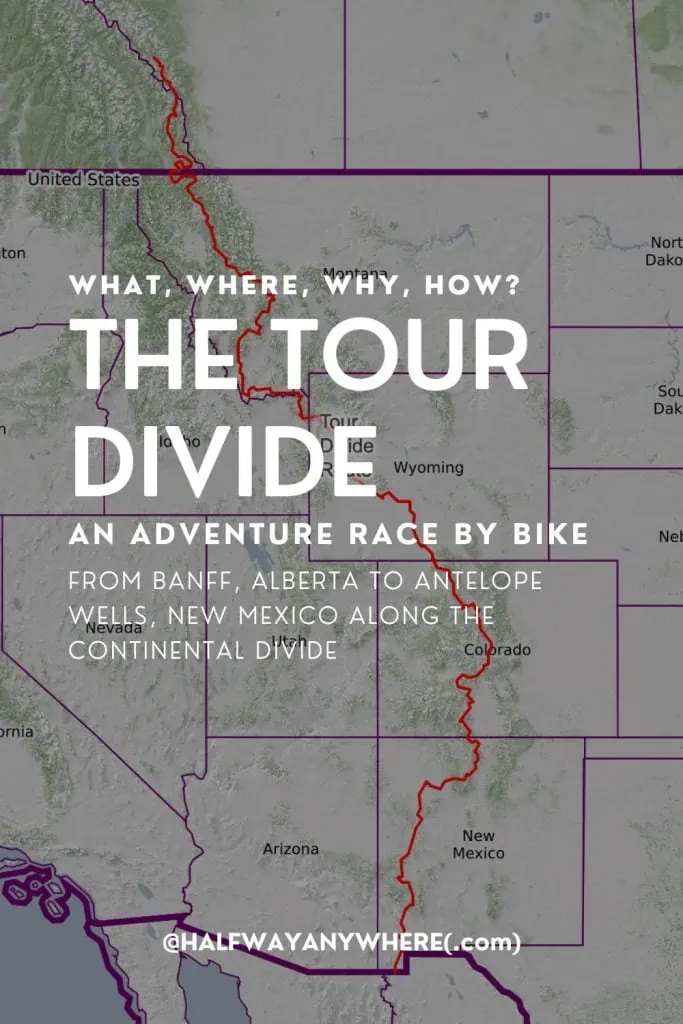
What Is the Great Divide Mountain Bike Route?
The northern terminus of the Great Divide Mountain Bike Route (GDMBR) is in Jasper (it was in Banff – the start of the Tour Divide – until 2018), a resort town in Alberta, Canada. It then heads south for over 3,000 mi / 4,800 km to its southern terminus at the US-Mexico Border at Antelope Wells, New Mexico. It can be ridden in either direction, but it’s traditionally ridden southbound.
Along with the Arizona Trail and the Colorado Trail, it comprises the most significant leg of bikepacking’s Triple Crown; similar to the thru-hiking Triple Crown comprised of the Pacific Crest Trail , Continental Divide Trail , and Appalachian Trail .
The route is almost entirely along dirt and gravel roads and is, for the most part, not a technical ride (i.e., you don’t need to be an expert-level mountain biker to navigate the GDMBR). Yes, there are a few short sections of singletrack, but overall, this route is suited for gravel or mountain bikes (but certainly not road bikes).
The GDMBR is approximately 3,000 mi / 4,800 km long and has over 133,000 ft / 40,500 m of climbing and an equal amount of descent. It passes through seven states/provinces: Alberta, British Columbia, Montana, Idaho, Wyoming, Colorado, and New Mexico. Despite beginning in Canada (as in riders must pass immigration at a border crossing), the route does not enter Mexico; it ends (or begins) at the US-Mexico Border.
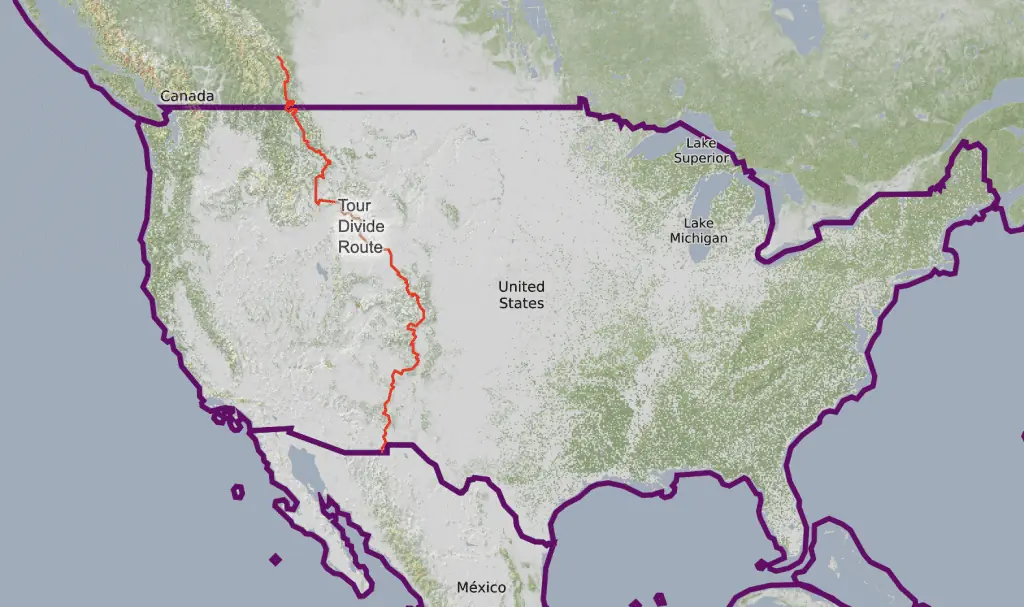
The Difference Between the Tour Divide and the GDMBR
You may be asking yourself, as I have, what’s the difference between the Tour Divide and the Great Divide Mountain Bike Route? The answer? Nothing. Kind of.
The Tour Divide is the name of the annual self-supported race of the GDMBR . Put another way, the Tour Divide follows the GDMBR. However, it begins in Banff instead of Jasper; Banff was the northern terminus of the GDMBR until 2018, when it was moved to Jasper. At least, that’s all you need to know if you’re not racing and/or riding the Tour Divide. What’s self-supported? It means that racers are only afforded resources available to everyone else participating.
For example, staying at a hotel? Perfectly fine. Staying at a friend’s house? Not okay.
When you drill down to the details, there are a few sections where the Tour Divide diverges from the GDMBR. But for all intents and purposes, they’re the same; again, unless you’re concerned about racing the Tour Dviide, then there are a few spots you need to take note of.
Every year, people bikepack all or part of the GDMBR on their own (in both directions). These people can take as much or as little time as they like – many presumably even enjoy their experience. Meanwhile, others decide to race the Tour Divide beginning on the second Friday of June at the northern terminus in Banff, Alberta (in Canada). The latter group’s enjoyment often falls more heavily into the Type II (or even Type III) fun category.
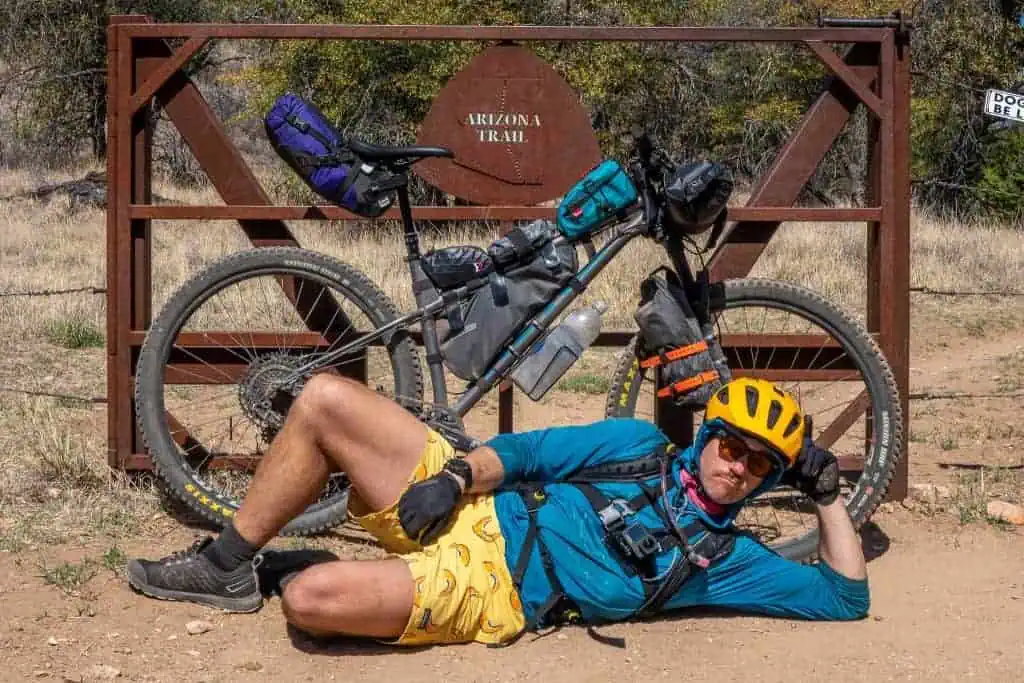
The GDMBR Versus the Continental Divide Trail
When I first hiked the Continental Divide Trail (CDT), I met one person in Island Park, Idaho, who was riding the Divide; I had no idea what they were doing, what the Tour Divide was, or what the GDMBR was. The cyclist was stoked to see me and my CDT hiking buddy, but we thought ourselves cooler than him because what could be cooler than hiking the CDT?
How things have changed. I apologize for not greeting you with the enthusiasm you deserved, anonymous 2017 Tour Divide racer.
Despite the CDT following a lot of dirt and gravel roads – that would be suitable for bikepacking – there’s actually very little overlap between the two routes. Yes, there will be opportunities for northbound CDT thru-hikers to see Tour Divide riders, but many will pass like ships in the night.
The Tour Divide starts too early for southbound CDT hikers to catch any riders, but they could still encounter northbound GDMBR riders during their thru-hikes. Remember, play nice if/when you see each other out there. We’re all out there doing awesome things in nature. There’s no need to perpetuate a bikepacker-backpacker divide (on the Divide).
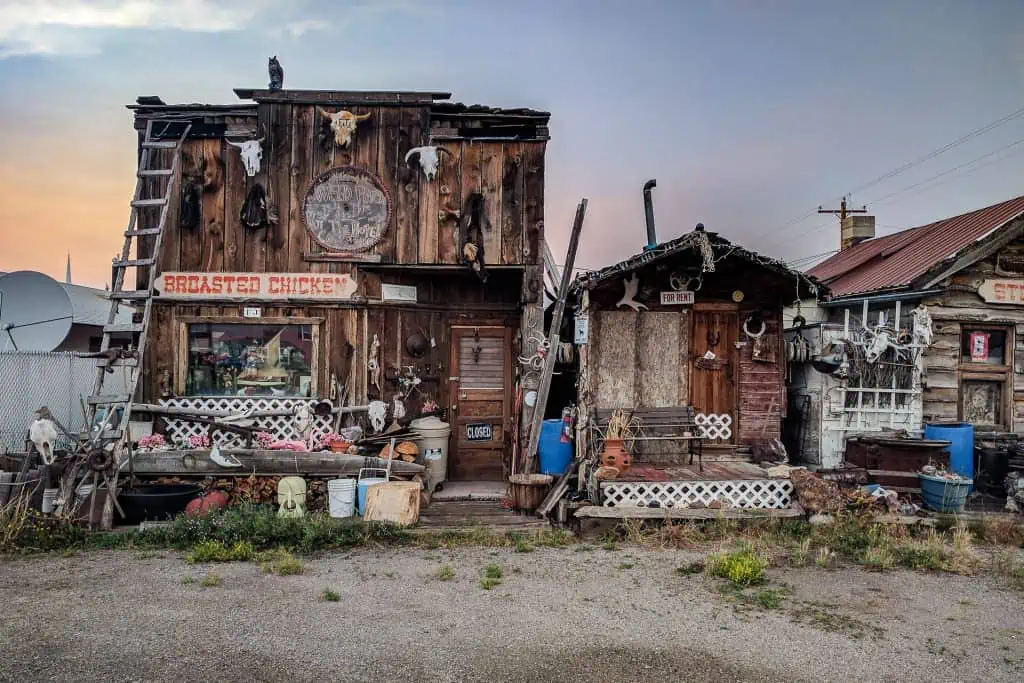
How to Participate in the Tour Divide
The community that has made the Tour Divide what it is today doesn’t exist as an official organization or entity. Instead, it’s willed into being by the yearly riding crop’s cohesion, carrying on traditions from and iterating upon actions of previous years’ cyclists.
There’s no sign-up form, no entry fee, no website (at least not a website updated in the last decade), and no organized event at the starting line in Banff (or at the finish line at Antelope Wells, New Mexico).
Most of the organization appears to come from Facebook groups (typically some of the most toxic online cesspools, but in rare cases, useful information corners). Every year, participants who provide tracking information (using a device such as a Garmin inReach Mini 2 ) to trackleaders can be watched online as they move down the course.
You show up in Banff, start riding south on the second Friday in June, tell anyone who asks that you’re riding the Tour Divide, and BOOM! you’re officially racing the Tour Divide. I’ve heard that in recent years that the community attempts to organize waves of riders (based on estimated finishing time) to ease impacts and congestion on/along the start of the race. Don’t want the local government to come in and try to shut down the unofficial race, after all.
Maybe one day, the magic of this unofficial, unorganized, organized, official bikepacking race will wane as permits, regulations, and rules are imposed with increasing popularity and awareness of the event. Maybe someone will write a best-selling book about the Tour Divide and blow it up like a certain unnamed book did to a certain unnamed trail in the Western United States.
Apparently, you’re supposed to send in a letter of intent to a random email address that I suspect is maintained by the crew at Bikepacking.com , but the letters of intent used to be posted to the Tour Divide website (which seems like it was a fun tradition that’s now sadly gone as of 2010).
For now, you only need to get on your bike and ride.
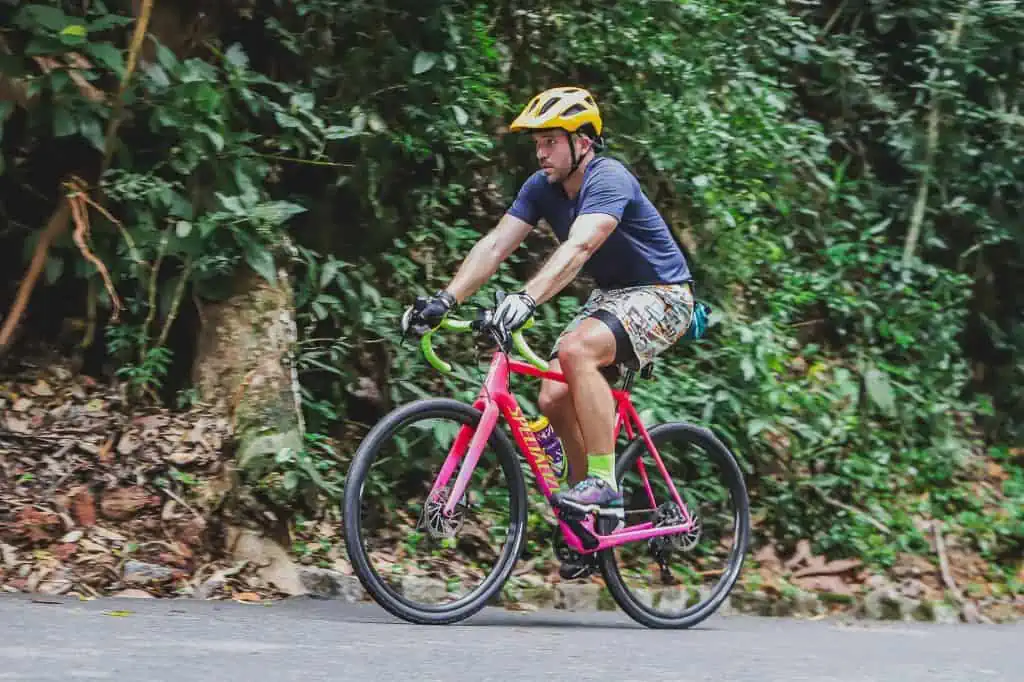
The Tour Divide is the unofficial orrifical self-supported race of the Great Divide Mountain Bike Route, with a few changes to the route. Simple enough, right?
It’s an incredible test of physical and mental endurance, with many riders forgoing sleep to put in more hours on the bike (how many hours I sleep every night is something I’m interested in seeing).
According to DotWatcher , since the Tour Divide’s conception in 2008, only 716 riders have completed the race (this number is likely not 100% accurate, but it’s about as good as we can do). Hopefully, after this year’s race, I will be able to count myself among the fewer than 1,000 total finishers.
For now, it’s time to go and ride my bike .
You'll Like These Too:
Share this post:.
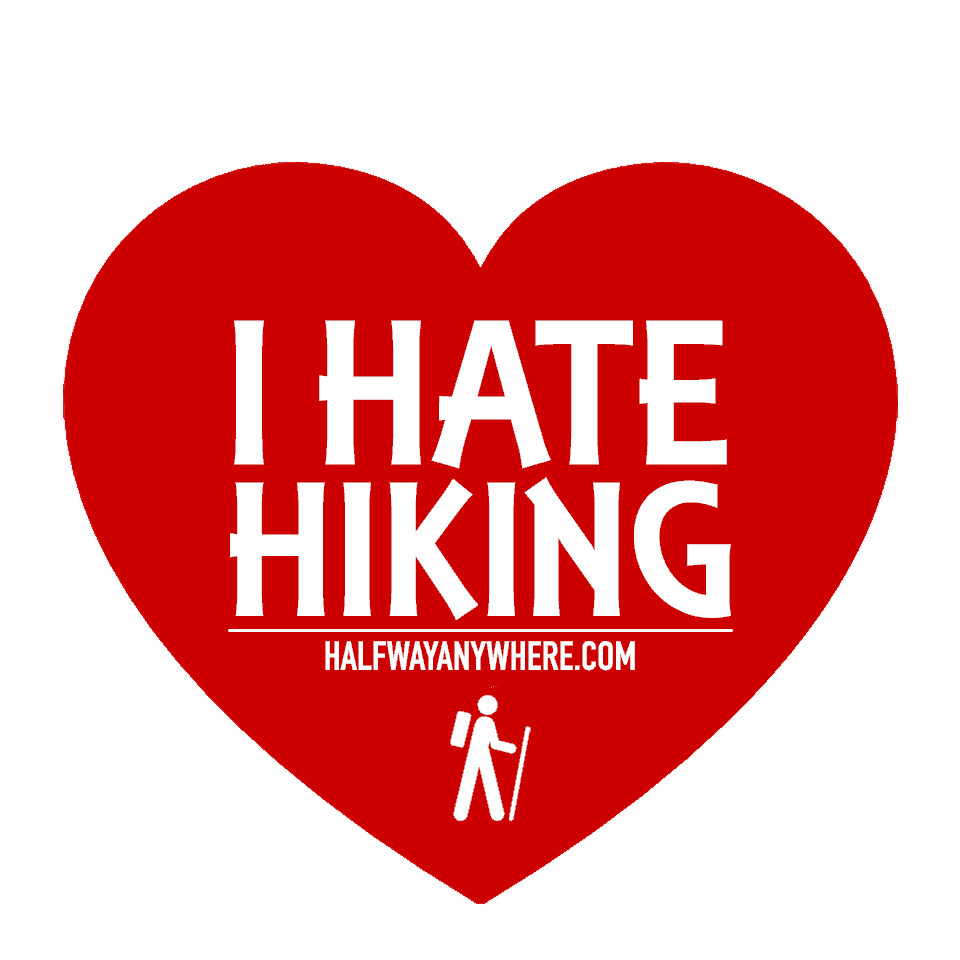
- Share full article

A 2,700-Mile Cycling Race Is Now Even More Extreme
The Tour Divide, a bikepacking race from the Canadian Rockies to the U.S. border with Mexico, has always been a test of fortitude. But extreme weather is making it much more dangerous.
Geof Blance riding the Tour Divide near Steamboat Springs, Colo. Credit... Daniel Brenner for The New York Times
Supported by
By Sabra Boyd
Sabra Boyd traveled from Banff, Alberta, to Antelope Wells, N.M., to follow the Tour Divide cyclists.
- July 4, 2022
Kevin Latta pushed his bike forward, following the Bull River down a ridge in the Canadian Rockies. The tire tracks from riders ahead of him had disappeared.
He searched for a shallow place to cross. But after just one step, the swollen river swept Latta and his bike downstream. Gripping the bike in one hand, he swam one-armed, dragging his gear through the churning current. He reached for a tree branch and hoped it would hold.
Two days before, about 200 cyclists had gathered in Banff, Alberta, to start the Tour Divide, an ultra-endurance event in bikepacking — backpacking by bike — that extends all the way to the U.S. border with Mexico. Some riders are professional athletes, others simply recreational cyclists with an interest in the extreme. There is no entry fee and no prize — only the glory of surviving one of the most grueling solo competitions in the world.
“It’s like the Wild West,” said Matthew Lee, a cyclist and organizer of the race — or “disorganizer,” as he calls himself.
The route twists through almost 2,700 miles of the Continental Divide’s alpine peaks, woodlands, picturesque towns and deserts. Most riders see bikepacking alone through the Rockies as a personal challenge, a transcendent test of their fortitude rather than a competition against others. But in recent years, extreme weather has become one of their most dangerous adversaries as they race against flash floods, landslides, driving winds and wildfires.

Bryce Meyer for The New York Times
Riders gathered in Banff, Alberta, to set off on the grueling course.
They ranged from professional cyclists to amateur enthusiasts who wanted to take on the challenge.
The first leg of the journey is through trails in the forest approaching the Canadian-U.S. border.
It can take anywhere from two weeks to two months to finish the race.
This year’s Tour Divide was supposed to mark a return to normal. The race was canceled in 2020 amid the coronavirus pandemic and shortened in 2021 because of pandemic-related border closures. But nothing about the race this year has been normal.
When it began on June 10, the cyclists knew that trouble might await them toward the finish: Wildfires were raging across hundreds of thousands of acres in New Mexico, the final state on the route. The fires were fueled by one of New Mexico’s driest spring seasons on record and by warmer temperatures linked to human-caused climate change. One of the fires, the state’s largest ever, was a prescribed burn that blazed out of control .
Near the start line on the morning of their departure, riders lamented that they would have to divert around some of the New Mexican scenery they had anticipated, like Gila National Forest. “It is what it is,” conceded Sofiane Sehili, an ultra-endurance racer from Paris.
Sara McDermott, who had arrived from Big Sky, Mont., said she had learned to plan for wildfires because of their inevitability on the course. “It feels claustrophobic,” she said. “I get a sore throat right away and a headache.” She and the other riders carried buff masks to cover their faces for riding through smoky conditions. Most planned to abandon the race if the smoke became too thick in Colorado or New Mexico.
A chorus of cheers erupted when the riders set off, startling magpies, crows and squirrels in the nearby forest. Bear bells jingled down the hill. Shoes snapped into pedals and bikes whizzed by.
The morning sky was blue and brisk. Only the nearby Bow River, muddy and swift with spring snowmelt, foreshadowed the dangers to come.
Airlifted out
Before the riders made it out of Canada, rain and snowstorms intercepted their path. The conditions complicated Latta’s encounter with the Bull River.
When Latta pulled himself out, he realized that his broken GPS device had sent him 10 miles bushwhacking in the wrong direction. “It didn’t occur to me that I was off the route,” he said. “I just thought this was the continuing sadism of the 2022 Tour Divide.”
Inching back up the ridge, “I was literally moving my bike 10 feet at a time,” Latta said. “And I would say, ‘OK, I’m going to go to that rock, then rest.’” When he spotted a tree that wasn’t covered in snow, he leaned his bike against its trunk and fell asleep, exhausted.
The storm was part of a particularly wet June in Fernie, British Columbia, which had more than five inches of rain, 20 percent above the average, according to Armel Castellan, a meteorologist for Environment and Climate Change Canada. Record-breaking rains last winter and the subsequent erosion also made rivers more prone to flooding, Castellan said.
Once he reached a road, Latta caught a ride to Fernie from a forest service truck. The Tour Divide has few rules, but because Latta accepted the assistance, he voluntarily disqualified himself. Yet he was still determined to finish what he had started and ride the rest of the route to Mexico.
The 15 cyclists airlifted out were not so lucky. “They tried to push their bikes for six or seven hours through wet snow,” said Simon Piney, the head of search and rescue in Fernie. “Bike riders aren’t well equipped to get through those types of conditions.” Eleven cyclists were treated for hypothermia and four for trauma, he said.
“From a rescue perspective, this stretched our resources considerably because of the flooding in the valley,” Piney said, adding, “We’re happy that nobody died.”

Lido Vizzutti for The New York Times
The tormenting rain and cold weather made for difficult and sometimes dangerous conditions for the riders navigating through Montana.
A.J. DeLauder, from Aurora, W.Va., commiserated with other Tour Divide riders after reaching a hotel in Bigfork, Mont.
“This rain is biblical,” DeLauder said. Earlier in the day, DeLauder had taken shelter in a baseball field dugout to escape the rain and change out of wet gloves.
DeLauder had feared hypothermia, but managed to get to the hotel in Bigfork to warm up.
Paul Anson, a cyclist from Britain, was one of the airlifted riders, though his circumstances were unique: His bear spray canister exploded, causing him to swerve and hit a rock. “Seven broken ribs are a tough price to pay,” Anson said.
The conditions farther along the course were no better. The same weekend, destructive flooding and mudslides caused by record rain and melting snow forced the closure of Yellowstone National Park , which the Tour Divide route skirts as it meanders through Montana, Idaho and Wyoming. And the threat of wildfires still loomed farther south.
Increasing dangers
The Tour Divide has had a free-for-all nature since the Adventure Cycling Association first mapped the route in the 1990s. “The spirit of the event has always been anti-establishment,” said Lee, the race organizer. This approach has fostered a tight-knit community among the cyclists.
“I love that it belongs to us,” said Alexandera Houchin, who holds the women’s record on a single-speed bike : 18 days 20 hours 26 minutes. “The ultra-endurance community is like my family.”
“It’s become ceremony for me,” added Houchin, who is an Anishinaabe citizen of the Fond du Lac Band of Lake Superior Chippewa. “And I think that’s something a lot of my Indigenous brothers and sisters can relate to. I just want more Native people riding.”
The fastest riders finish the Tour Divide in just over two weeks. For others, the grueling trek can take two months. To save time, many sleep four to six hours a night in a sleeping bag shell called a bivouac sack.
Riders have always faced dangers on the Tour Divide, including bears, blisters, dehydration and smoke inhalation. A cyclist was killed in a collision with a truck during the race in 2010. Last July, a violent grizzly bear attack occurred in a Montana town where many bikepackers camp.
The effects of climate change have only increased the danger.
During last year’s race, flames lined the horizon as Sarah Swallow , a Tour Divide competitor, headed toward the Yampa River. It was the third day of Colorado’s Muddy Slide Fire , and smoke shrouded the sun in a pulsing fluorescent shade of orange. Swallow pushed up one last hill, needing to reach the river before local officials closed the crossing. Her only other option was to detour onto a long, busy highway, and that was time she couldn’t afford to lose.
The smoke billowed as Swallow made it across a dam. The road closed behind her. Helicopters flew in search of more water as residents evacuated .
“In the time that it took me to ride past the fire, the winds picked up and I watched it go from a really small thing of smoke to 50 times bigger,” Swallow recalled. “The smoke plume followed me. When I was camping that night, it rained ash.” She is not competing in the Tour Divide this year, partly, she said, because of the extended fire season.
Leighton White, a firefighter in Steamboat Springs, Colo., fought the blaze that Swallow raced against. He is also a former Tour Divide rider. “Around 2009, you could see the exponential growth of dead trees” along the route, he said, noting how shorter winters and longer dry seasons have led to the explosion of bark beetle populations whose nests weaken lodgepole pines , turning entire mountainsides brown and killing young saplings.

Oak Creek Fire and Rescue
The Muddy Slide Fire affected the race in 2021.
The burn scar from the fire is adjacent to the route this year, near Steamboat Springs, Colo.
Sofiane Sehili of France, the leading cyclist of the race, crossed a river south of Steamboat Springs.
“In 2019 I was caught in the biggest June snowstorm in the history of Colorado,” he said. “I feel like anything can happen. So yes, definitely climate change. You can see it on this race.”
Tom Davis, left, a local resident, wanted to see Sehili on the course. They talked as they crossed paths.
Fire has dashed many dreams on the Tour Divide in recent years. Lael Wilcox, who in 2015 set the Tour Divide women’s record of 15 days 10 hours 59 minutes, attempted an individual time trial last August to try to beat Mike Hall’s record of 13 days 22 hours 51 minutes. (Hall, who set the record in 2016, was fatally struck by a car in an Australian race the next year.)
But as Wilcox began her attempt, smoke from nearby wildfires permeated the air almost from the start. “It was just awful,” Wilcox said. “I mean, you’re in this beautiful place and you can’t even see the mountains because it’s a layer of white.” Four days in, Wilcox was forced to leave the course. Her lungs were shutting down from the smoke.
The planet’s warming climate has extended the wildfire season in the American West, increasing the risk from larger, more frequent blazes. “We are no longer waiting for climate change to happen,” said Kira Minehart, a doctoral student at Oregon State University’s College of Forestry, who rode a section of the Tour Divide two years ago. “It is right here and now.”
As snowpack declines in many places, Minehart said, the consequences can be dire for Tour Divide riders, who prefer to filter water along the way instead of carrying gallons of water that can slow them down. It can also be catastrophic for the landscape, since snowpack can help mitigate wildfires.
Jalen Bazile, a founder of the Black Foxes , a collective of Black cyclists, emphasized the importance of training and preparation to avoid making panicked decisions in unfamiliar environments. Riding the Tour Divide in 2017, Bazile had to reroute 300 miles to avoid a Montana wildfire. Bikepacking, he said, “forces us to really take inventory of who we are and what we’re capable of.”
A triumphant finish
Sehili, the racer from Paris, crossed from Colorado into New Mexico in first place, just as the Southwest’s monsoon season arrived to help extinguish the raging fires. The winds that cyclists had been riding against for nearly two weeks — winds that had whipped up flames across the desert — now brought torrential rain. The risk of heavy rainfall and more dangerous flooding after wildfires has been exacerbated by global warming , a recent study found.
Thunder silenced the cicadas, and the humid air was filled with the spicy-citrus scent of the creosote bush. Soon, Sehili and his bike were covered in what he called “New Mexico death mud.”
Andy Leveto, a rider from Bellingham, Wash., welcomed the rain — “my first shower in a week.” But his goal of riding through the Polvadera Mesa, which he had heard was a “beautiful, gorgeous, kind of rough and unrelenting section,” was spoiled by a detour put in place because of the wildfires. Leveto would finish the race fifth.

Ramsay de Give for The New York Times
Tyler Gatlin and Patrick McKellips crossed the Abiquiu Dam in New Mexico.
Gatlin was about halfway through New Mexico on Saturday.
McKellips took a break to talk to a biker who was starting the Tour Divide route northbound.
McKellips and Gatlin bought drinks and snacks at a grocery store. Cyclists venture into the towns on the route to resupply and rest when they need to.
Carl Gable made his way down a stretch of New Mexico road.
Sehili came close to breaking Hall’s course record, crossing the finish line in Antelope Wells, N.M., at 11:36 p.m. on June 24, after more than 14 days on his bike. He was greeted by a group of fans and friends. Somehow, after thousands of miles, he found the strength to lift his bike above his head for a photo.
To break the record someday, Sehili said he would need to pick a different date for an independent time trial because June has become too unpredictable with its fires, floods and winds. “In 2019 I was caught in the biggest June snowstorm in the history of Colorado,” he said. “I feel like anything can happen. So yes, definitely climate change. You can see it on this race.”
After taking some selfies, Sehili and the group gathered at Jeffery Sharp’s bike ranch. At the property’s entrance, a bicycle shrine adorned with artwork, raw turquoise stones, sun-weathered bike shoes and a placard engraved with “Mexico” greets visitors.
Everyone went to the main room, where a laptop tracked the other racers. Two chiropterologists researching local bats baked pizza while a ranch hand named Jimbo made sure everyone had drinks. Sehili sat for an interview with the “ Bikes or Death ” podcast while he held an ice pack on his leg.
“I think this might hurt,” said Mallory Davies, one of the bat researchers, who had a first aid kit and helped Sehili bandage an injury. “I don’t think so,” Sehili said. “I’m a bikepacker.”
Sehili laughed when asked whether the heavy rain was good luck for the race because the storms helped put out some wildfires. He said that in the hierarchy of bad conditions, the worst is riding into 45-mile-per-hour winds.
In recent years, racing the Tour Divide has been as unpredictable as a wildfire in New Mexico or destructive floods in Yellowstone. Some of the bikepackers still on the route may yet encounter new fires or other hazards.
Ultimately, the Tour Divide is like most ultra-endurance races: If you make it to the end, you’ve won.

Explore Our Weather Coverage
Extreme Weather Maps: Track the possibility of extreme weather in the places that are important to you .
Tornado Alerts: A tornado warning demands instant action. Here’s what to do if one comes your way .
Climate Change: What’s causing global warming? How can we fix it? Our F.A.Q. tackles your climate questions big and small .
Evacuating Pets: When disaster strikes, household pets’ lives are among the most vulnerable. You can avoid the worst by planning ahead .
Advertisement
- the Route (description)
- The Challenge
- Grand Départ
- Rider Resources
- News & Notes (blog)
- News & Notes
- `11 Race Updates
- `11 Rider Call-Ins
- `11 ITTD Updates
- `10 Race Updates
- `10 ITTD Updates
- `09 Race Updates
- `09 ITTD Updates
- `08 Race Updates
- About Start List
- `11 TD Start List
- `11 ITT-D Start List
- `11 Letters of Intent
- `10 TD Start List
- `10 Letters of Intent
- Start List & LOI Archive
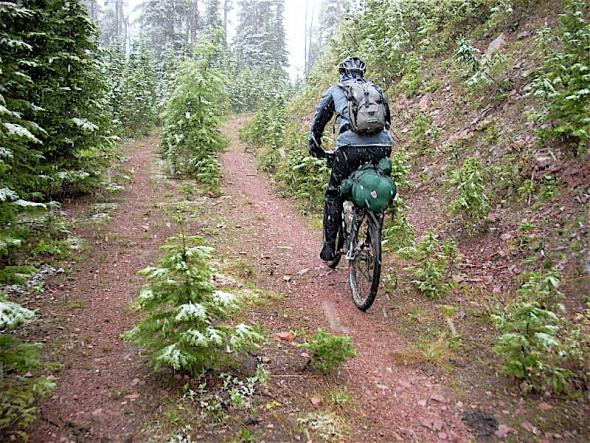
Tour Divide challenges a fixed course annually called the Great Divide Mountain Bike Route . Not only is the Great Divide Route a true classic, its 'primary track' is pursued with consistency by TD athletes so that year to year, finish times may always be compared directly to the record books .
The Great Divide Route is the world's longest off-pavement cycling route. It was tirelessly mapped over a 4 year span, and published in 1998 by Adventure Cycling Association, North America's premiere bicycle travel organization. The route is highlighted by long dirt roads and jeep trails that wend their way through forgotten passes of the Continental Divide . It travels through Canadian provinces of Alberta and British Columbia, and the United States of Montana, Idaho, Wyoming, Colorado, and New Mexico ( map ). By route's end a thru-rider will climb nearly 200,000 feet of vertical (equivalent to summiting Mount Everest from sea-level 7 times).
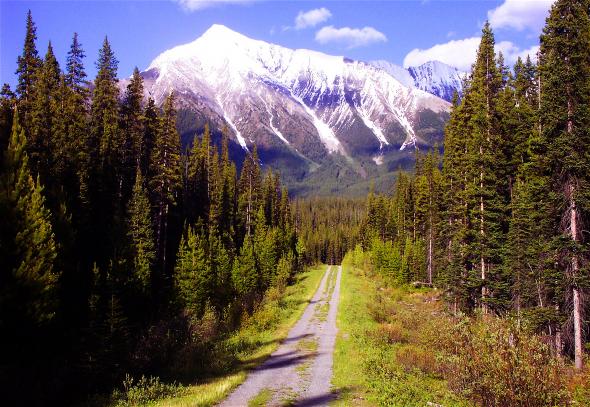
It is by riding a bicycle that you learn the contours of a country best, since you have to sweat up the hills and coast down them. –Ernest Hemingway
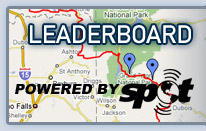
Tour Divide 2023 : The race, the gear, the whys and everything in between
- May 13, 2023
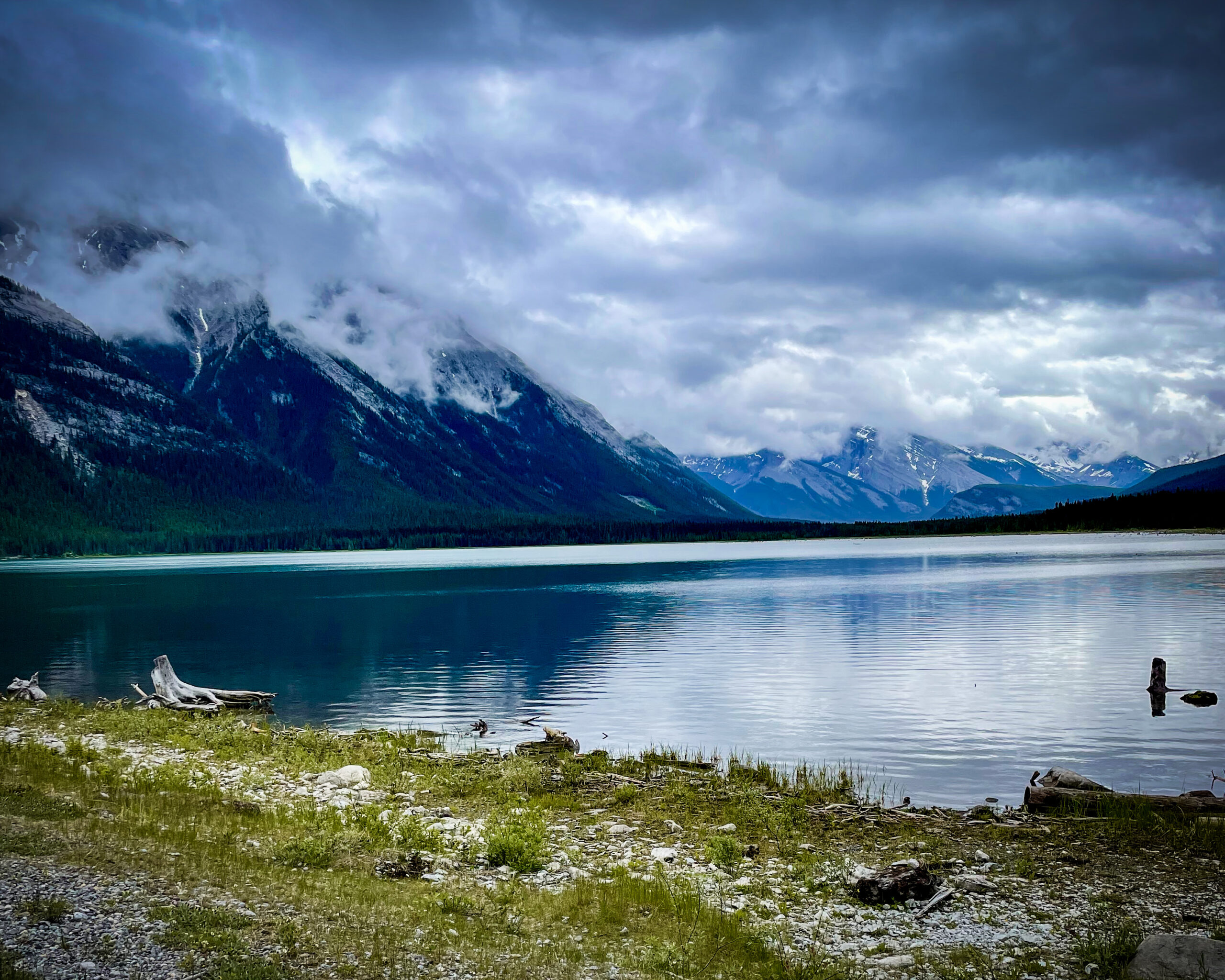
It was just over 2 years ago the first time I ever heard of the Tour Divide. I didn’t even know what bikepacking was or that bikepacking racing was a thing.
By then, I had become a time trialist specialist on the road. I had become obsessed with mastering my mind, mastering the art of executing a perfect time trial. I love it so much. I know very well this feeling, my sight on the road ahead, my head tucked in, my lungs expanding to their max, my legs flowing over the pedals. That feeling when I get in the zone, when I’m able to fully surrender and let no amount of pain bother me. It’s pretty amazing. And quite freeing.
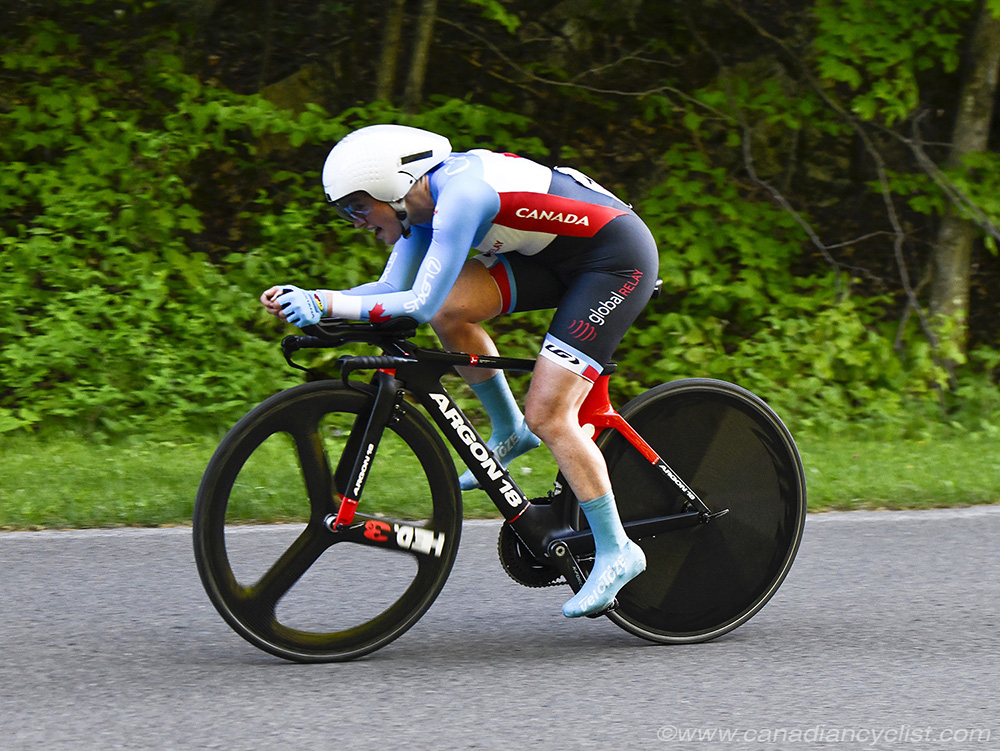
A few years ago when I was reading this passionating book “How Bad Do You Want It”, the author spoke of how references are limiters to the mind and the body. If you can remove the information that you know as your references, you could push your body much further. I decided to test the concept and did a 20-minutes blind test – no numbers, no references. Increasing my best 20-min power by 18% was a shocking, yet insightful experience. “You are stronger than you think.” Simply remove the thinking.
I was on the stationary bike trainer when a youtube video came up about the Tour Divide (the documentary was I Just Want to Ride featuring Lael Wilcox – record-holder of the fastest female time on the Tour Divide). A 4,300 km time trial. WOAH! Now everything I know as references are quite irrelevant. How the hell is this humanely possible? Then… What if I remove what I know as possible. What if this was just another example of the amazing things a body can do when you remove references. I was immediately filled with curiosity.
I couldn’t sleep that night. I had to find out: where is the limit of what I can do. Am I able to apply what I came to master in road cycling time trial to a 4,300km bikepacking time trial?
Covering a distance of 4,300km, the Tour Divide is one of the longest and arguably the hardest ultra-endurance bike race on the planet. From Banff (Alberta) in Canada, to Antelope Wells (NM) at the border of Mexico, the course takes the riders along breathtaking scenic landscapes of the Great Divide Mountain Bike Route (designed by the Adventure Cycling Association back in the 1990s), one of the most well-known off-road touring route that attracts bikepackers and bike tourists from all over the world.
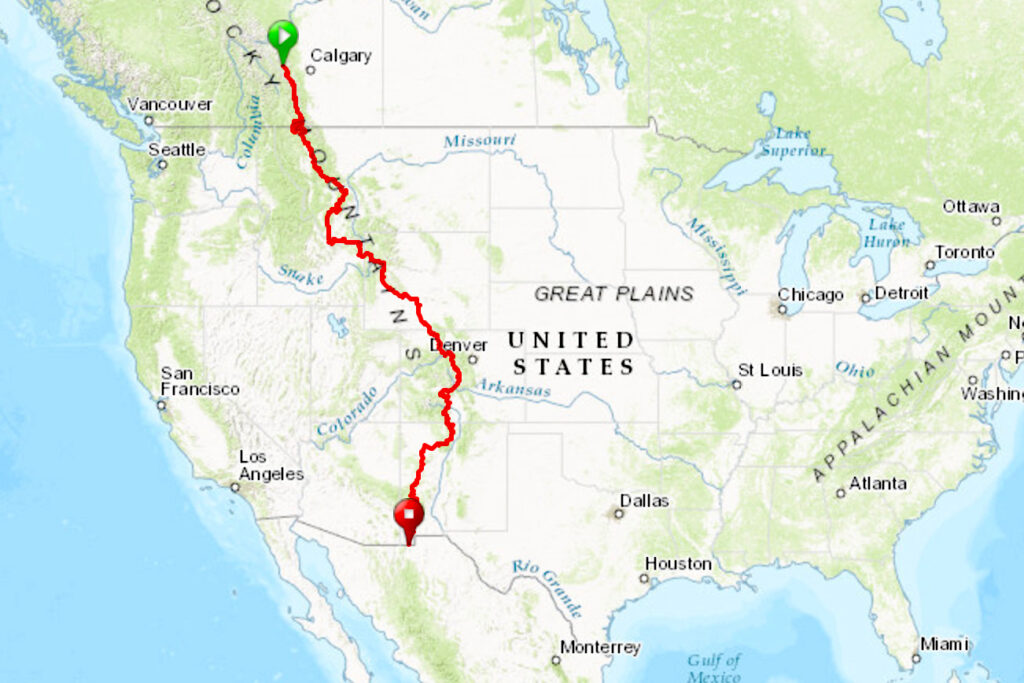
The race has been going on for many years, starting on the 2nd Friday of June of each year, but only started to gain popularity lately with the rise of bikepacking and bikepacking events. The 2023 edition has currently over 250 participants registered to this day (one month before the start). 26 of them are female or non-binary, the highest non-male participation rate ever!
The Tour Divide is more than a cycling race, it is the definition of an endurance and resilience test. The race is self-supported, which means you are not allowed to receive any help. You can use public services such as hotels and restaurants, but you must carry everything you need (clothes, food, camp & sleep, tools). The route goes through many remote areas where a satellite device is the only way of communication. High-altitude mountain passes, changing weather, and wildlife encounters are all part of the race.
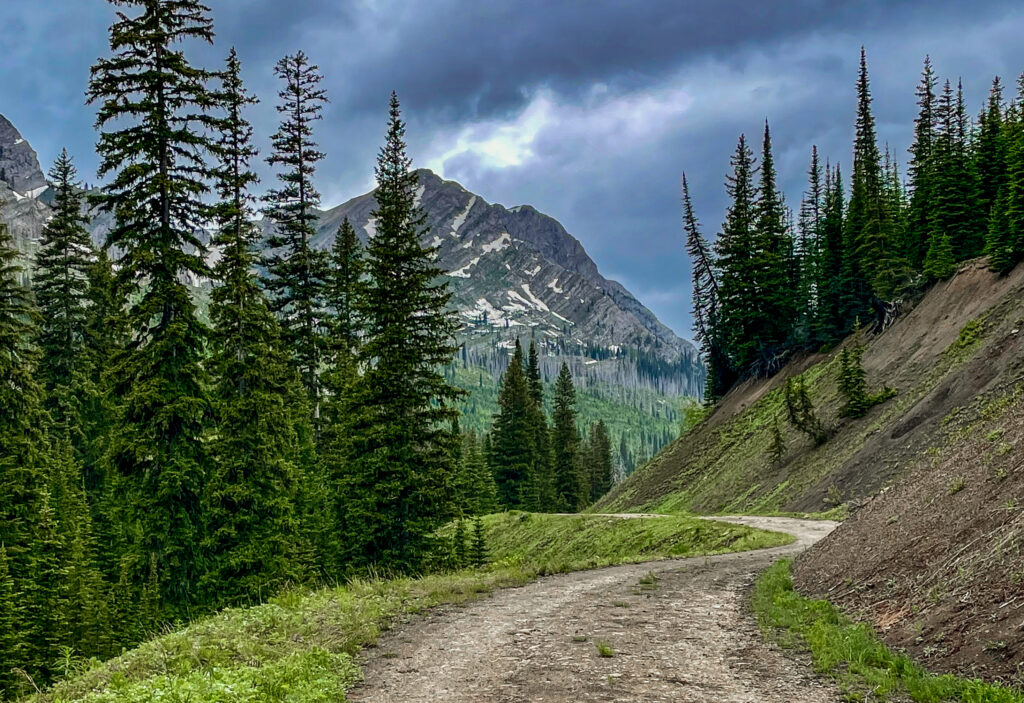
Getting ready – my journey to the start line
There is the physical journey, then it’s freacking scary! 2 years ago I had never camped before, never packed gear on a bike, never ridden in the dark or encountered a bear.
Before I could attempt this, I had a few classes to take on. So, 3 weeks after watching the youtube video about the Tour Divide, I departed for my first bikepacking trip. An improvised, but oh so life-changing, one-month bikepacking trip in Utah and Arizona hooked me up. From there, I would use bikepacking for training when I’m not racing.
Last year (2022), I was still racing as a pro road cyclist when a series of events occurred, one of them being the cancellation of BC Superweek, my beloved crit series in July. I was going to fly to western Canada (near Banff) for Road Nationals, but then I had an opening in my calendar. “What a great opportunity to check out the course of the Tour Divide!” I thought.
I flew with all the gear I had and set to ride as much as I can of the route after racing Nationals. I had a wonderful ride in the time trial at Nationals, I rode the absolute best I could. Another 2nd place, but I felt satisfied. I love when I leave it all on the course. I was not going to be National Champion but that’s how it is. I don’t have less joy riding my bike fullgas. It was time to swap bikes.
So, a week later on July 4th, 2022, I departed from Banff and headed south on my pretty beat-up Cannondale FSi mountain bike hardtail, to see if I was capable of riding the terrain, to overcome my fear of bears (oh, I did come face-to-face with a grizzly! But that’s for another storytelling time), to overcome my fear of riding in the dark and confronting the weather of the high-altitude mountain passes.
The course was absolutely mind-blowing!!! Every day, I was overwhelmed by the beauty of the landscapes surrounding me. The “non-technical” terrain was very much challenging for my roadie skillset. I was very unprepared for the hike-a-bike and the rain, but it was so empowering to come out of these challenges stronger.
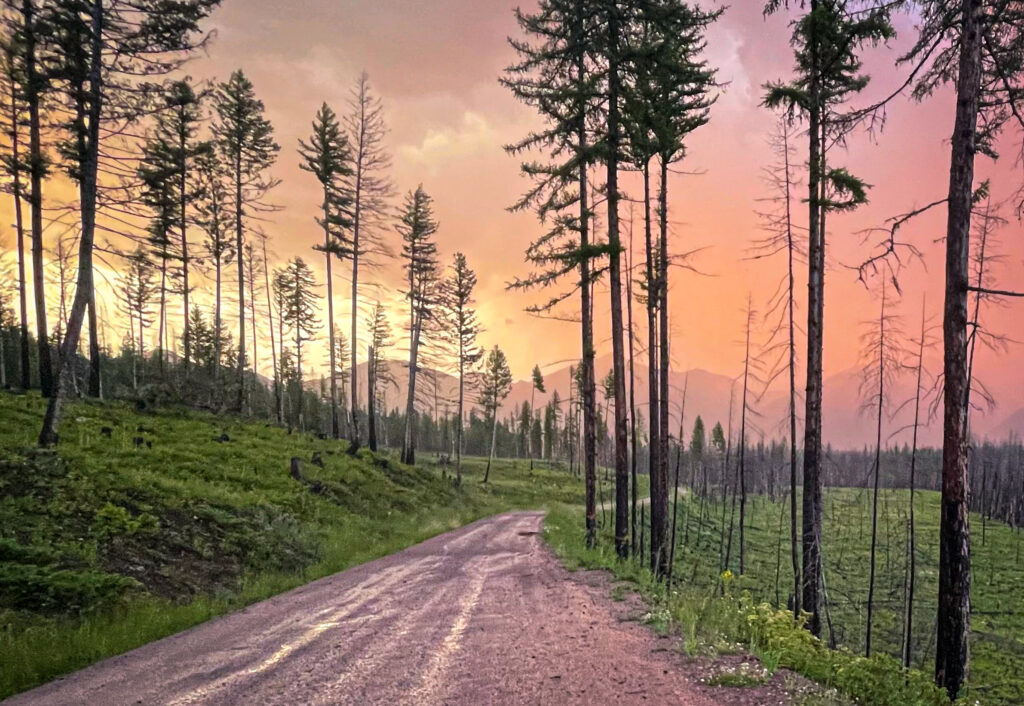
I completed the route in 28 days (about twice as long as the race-winning time), averaging over 10 hours of riding to cover 150km each day -it was the hardest thing I had ever done !!
This course recon was the first step to getting prepared to race. It also made obvious that I needed to improve my MTB skills, to strengthen my upper body for the hike”push”-a-bike, to fasten my camp-to-bike transition, a warmer and more reliable sleep system, and better overall gear and bike.
My 2023 Tour Divide Gear List
By now I have gathered enough bikepacking experience to know better what I want and need for my ideal setup. So I have reached out to my favorite companies and I’m very fortunate that they embarked on my dream race project with me! Here is the best bikepacking setup I could build for racing the Tour Divide :
- Cannondale Scalpel HT, 100mm suspension fork
- Sram X01 mechanical 34T x 10-52 Eagle cassette
- SL4 Lucky Jack – Duke Racing Wheels (XC carbon wheels, 1200g a pair)
- Son 28 dynamo hub
- Ergo grips and aero bars
- Maxxis Ardent Race and Ikon 2,2 tires
Packs: Backcountry Series by Apidura
- Apidura 11L handlebar pack (clothes)
- Apidura 2x 1.2L feed pouches, 1L top-tube feed bag, 1L rear top-tube pack for accessories
- Apidura 4L frame pack with a hydration bladder (food & water)
- Apidura 1.8L down-tube pack (tools and pharmacy)
- Apidura 10L saddle pack (sleep system)
- possibly a hip pack or hydration vest… TBD
- 7mesh cargo bib (pad removed) paired with 7mesh Foundation Shorts
- 7mesh Hollyburn light thermal pants
- 7mesh Chico Anorak pull-over
- 7mesh merino buff
- 7mesh Skypilot Gore-tex rain jacket
- MEC 800-down jacket
- Mountain Hardwear 800-down pants
- MEC rain pants cover
- Showerpass waterproof gloves and socks (available at MEC)
- Defeet merino gloves
Sleep System :
- MEC Talon 0 degree C 800-down quilt
- MEC Vectair Ultralight insulated air mat
- Mountain Laurel Designs FKT bivy
- Warmlite Gear Vapor barrier long-sleeve jersey
- Warmlite Gear Vapor Barrier socks
Electronics :
- Garmin 540 Solar for navigation (MEC)
- Garmin inReach satellite tracking (MEC)
- GoPro Mini 11 for self-documenting the race
- iPhone and AirPods
- Sinewave Cycle Beacon2 headlight (dynamo powered)
- 1x 5,000 mpa power bank, 1x 10,000 mpa power bank, fast-charging wall charger, and cables
- Black Diamond headlight (MEC)
- Set of rear lights (MEC)
Tools, toiletry, and other items :
- Sunscreen (lots of sunscreens)
- Toothbrush, toothpaste
- Laundry handwash soap
- Eye mask, ear plugs
- ibuprofen, allergy med
- Caffeine, melatonin
- BeFree water filter and water purifying tablets
- Muc-Off Hydro chain lube with a rag
- Hand pump, tire plugs and sealant
- Multi-tools with chain breaker
- Spare derailer hanger, spare brake pads, chain links
- Patch repair kit
- Protein powder, BCAAs, Greens powder
Thank you to my sponsors for gearing me up with the best. Find this gear online: MEC outdoor gear , 7mesh cycling apparel , Apidura bikepacking bags , Duke Racing Wheels , Warmlite Gear vapor barrier gear .
Live-Tracking – From June 9th, 2023
We will depart from Banff (AB) on June 9th, 2023. You can follow the race live via satellite tracking here .
Even though I will try to film as much as possible, I will not be posting a lot on social media during the race (because it’s a race!) and there isn’t much service between towns. If you do follow my progress, I will love to read your messages of encouragement!
You can find me on instagram at @msoleilblais74 and you can subscribe to my Youtube Channel to be notified when my Tour Divide film is up!
But why in the hell would someone want to race this?
I have long asked myself this question. What is my motivation, why do I want to race the Tour Divide and put all of the efforts behind such a big commitment? Multiple answers come to my mind.
First, it’s the curiosity, the need to push the limits and see how far I can go. I see this as a continuation of my fascination for the power of the mind and playing with the concept of removing references. To see what I could do if I go into something where I have no references at all. Can I carry my time trial state of mind over 4,300km ? How resilient am I?
Second, it’s the transformation. Endurance has never been something I particularly excel at naturally. I had a strong anaerobic profile as a pro cyclist but that is quite useless over a long distance. I think you never become ready for the biggest race of your life, just like you don’t do a marathon before your first marathon. You “become” someone who is capable of doing it, by doing it. I want to become the person at the finish line who was able to race that distance and push her limits to a new level. No matter what happens, I will come out of this test stronger and more resilient.
Lastly, I want to live the experience. The experience of racing my bike all day, all night. Riding as far as I can, every day, with nothing else on my mind than going further. I quite enjoy the solitude of riding long distances in remote areas, and I look forward to re-discovering the magnificent, yet challenging course that is the Tour Divide.
Stay tuned, peace out
Full heart, fullgas
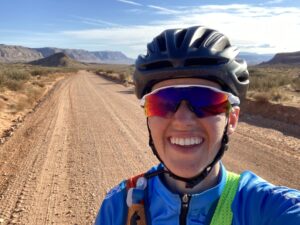
Marie-Soleil Blais
Bike Racer & Adventurer
You might also enjoy
A bikepacking story – full film release.
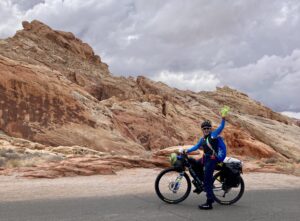
Bikepacking 101 – Tips for your first bikepacking or bike touring trip

- View Latest/All
- Bikepacking Videos
- Your Stories
- Rider's Lens
- Field Trips
Popular Tags
- #bikerafting
- #Tour-Divide
- #family-bikepacking
- #winter-bikepacking
- #1Q5V (1 Question 5 Voices)
Gear/Reviews
- Bikepacking Bags
- Camping Gear
- Accessories
- #Editors-Dozen (Our Favorite Gear)
- #Gear-of-the-Year
- #MYOBG (DIY)
- #Decade-in-Review (Best of All Time)
The Gear Index
Latest indexes.
- Mini Panniers
- Saddlebags & Top Openers
- Cargo Cages & Anything Bags
- Gravel Bars
- Drop Bar 29ers
Bikepacking Bikes
- Rigid & Plus Bikes
- Drop-bar & Gravel
- Full Suspension
Rigs & Roundups
- Rider & Rig
- Race/Event Rig Roundups
- Worthy Builds
- Handbuilt Bikes
- #29+ (29-plus)
- #vintage-mountain-bikes
- #cargo-bikes
- Readers' Rigs (Dispatch)
- New Bikes (Dispatch)
Plan Your Trip
Bikepacking guides.
- Bikepacking Food
- Gear & Pack Lists
- Bike Photography
Essential Reading
- Leave No Trace (for Bikepackers)
- Guide To Bikepacking Bags
- Bikepacking Gear That Lasts
- #Bikepacking-Awards
- Power Of An Overnighter
- Advice For New Bikepackers
- Our Favorite Bikepacking Routes
-
Where to Begin
We have over 300 original and curated bikepacking routes in our global network spanning nearly 50 countries.

Start at our worldwide routes map to dig into our detailed guides with GPS maps and inspiring photography.
By Location
- The United States
- Latin America
- Middle East
By Length (days)
- Overnighters & S24O
- Weekend Routes (2-4)
- Week-long Routes (5-10)
- Odyssey Routes (11-30)
- "Freakouts" (31+)
Local Overnighters
The Local Overnighters Project is a unified effort to document and map one-night bikepacking routes all over the world—by locals, in their own backyards.
The Bikepacking Journal is our biannual printed publication. Each issue features a collection of inspiring writing and beautiful photography. Find details on the three most recent issues below, join the Bikepacking Collective to get it in the mail (anywhere in the world), or click here to find a collection of selected stories in digital format.

The special edition 10th issue of The Bikepacking Journal is one you won’t want to miss! It features 25% more pages with extra stories, bonus art and maps, and much more...

Issue 09 takes readers on trips through time—one to the early days of bicycles—and offers several reminders to be grateful for supportive friends and family, and strangers we meet along the way...

For Issue 08, we invited several contributors to return and pick up where earlier trips and ideas left off and also feature a handful of first-timers whose perspectives we’ve long been eager to share...

One Question, Five Voices: Taking on the Tour Divide

In our third installment of One Question, Five Voices, we ask a group of Tour Divide finishers to share their secrets for mentally preparing to race from Banff to Mexico along the Great Divide Mountain Bike Route. Read on to glean some insights for getting into the Tour Divide mindset, whether you’re hoping to set a new record or just want to make it to the finish…
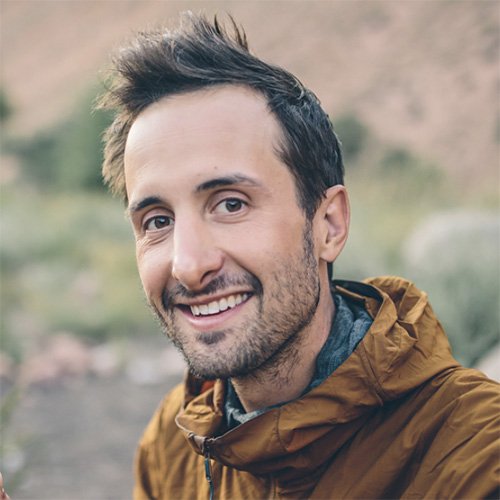
Cover image by Brett Ziegler ( @bziegler )
Have you ever wondered what it takes to prepare your mind (and body) to take on a massive race like the 2,700-mile Tour Divide? We did, so we asked five inspiring riders to share their pre-race strategies and routines. Plus, as a bonus, we had them give us their picks for the best Tour Divide tire.
How do you mentally prepare yourself to take on the Tour Divide?

Neil Beltchenko
Crested butte, co.
Fear is what prevents many people from starting the Tour Divide in the first place, and rightfully so. Some will also quit midway through due to fear. A two, three, four week race is demanding, and while physical power is an important aspect, being mentally prepared is crucial. If you’re not mentally prepared to be beaten down, cold, wet, dealing with a nagging injury, alone, scared of the dark, scorching hot, dehydrated, out of food and water, dealing with a flat, broken spokes, blown up dynamo hub or bottom bracket bearing, tired of riding, or missing your family and friends, simply remind yourself this is an endeavor you signed up for, and one that is 100% attainable.
A useful exercise I do prior to all of my big bikepacking rides (and even day rides, occasionally) is to think about a realistic scenario I might encounter on the trail and how I’d react when it happens. I think about things like how to handle a slashed side wall, a mechanical problem, a heavy storm, a closed store when I’ve banked on it being open, and so on. Expect the worst, because the worst is bound to happen at some point over the course of your ride. Knowing how to react will get you though those moments.
Another thing I do to prepare is make sure my bike is completely dialed before the race. Are my bags properly attached? My tire pressure set, bolts tight, and calories accounted for? Do I have enough batteries for my lights, and do I have a back up way to navigate? I’ll also make sure my body is rested, which will help me mentally focus on the task ahead.
For most people, the Tour Divide is more of a mental battle than a physical one. Nothing can replace experience, and that’s why it took me years to finally take it on. My final piece of advice is this: the morning of the race, sit at the end of your bed and tell yourself that you’re going to finish this beast, because there’s nothing sweeter than standing in Antelope Wells with a beer in hand, knowing you just rode down the entire spine of the United States.

Lael Wilcox
Anchorage, ak.
I ride to the start. Both times that I raced the Tour Divide in 2015, I rode from my home in Anchorage, Alaska. The first time, I left Anchorage on May 4 to ride 2,100 miles from Anchorage to Banff. I took a week off and then started with the Grand Depart. I had bronchitis-like symptoms and extreme difficulty breathing on the first day of the race. I nearly dropped out, but struggled through the first week until admitting myself to the emergency room in Helena, Montana, where I received antibiotics and an albuterol treatment.
Within a couple of days, my condition improved. I increased my mileage and bested the existing women’s record by two days. Yet, I returned home to Anchorage feeling unsatisfied with my time. What if I hadn’t gotten sick? I knew I could ride faster. So, I biked out of town two weeks later. I rode from Anchorage to Whittier, took the ferry to Bellingham, and rode 850 miles to Banff. I took a week off before setting out for an individual time trial on the Tour Divide. During that attempt, I took another day and a half off my time from June, setting the women’s record at 15 days, 10 hours.
Riding to the start of a race gives me time to acclimate. I become in tune with my bike and the weather and the terrain. I think it’s particularly important to spend that much time in the saddle before an event. It allows my body to naturally find a comfortable position on the bike and gets me used to spending all day there. It also gives me time to think and prepare for the magnitude of the race.
The Tour Divide isn’t won in a day or two or three. The current record is 13 days, 22 hours, 51 minutes. Every minute counts the same as any other. To establish a fast time, you need to have the mental fortitude to sustain a level of urgency over a two-week period. As Mike Hall said, “You must crave miles.”

Jay Petervary
My mental prep is mostly driven by my goals and strategy. I think a lot as the start nears, and visualize the actual effort and processes it will take to achieve those goals. I walk through many different scenarios in my head. I visualize riding by myself, in the rain, walking through the mud, resupplying efficiently, and riding strong. I mentally go the distance, ending with the last pavement miles to the border and finishing the Tour Divide, which is always my primary goal.
Another part of my mental prep is having a “clean plate” and a clear head. That means making sure my home life is stable, the grass is cut, the bills are paid, there’s no static with my partner or friends, and so forth. Try to clean up all those loose ends! They will haunt you otherwise.
In the end, mental prep is important, but the real key to success is my approach and attitude when I take on such an adventure. My mental preparation (or lack thereof) stems from my personality, experiences, attitude, and perceptions. I don’t question whether I’m going to finish. I’m not nervous about sleeping outside in bear country. I don’t wonder what I am going to do if my bike breaks, nor do I worry about my mental fortitude or toughness. I love being out there and I look forward to the unknown in hopes of learning more about myself.
Jay’s tips:
- Be confident , but not cocky.
- Be stoked , live in the moment, and embrace what you are doing.
- Be positive and take the good with the bad. For example, rain and mud just mean a chance to nap!
- Forget the words “stop” and “quit.” There’s only one place to stop, and that’s Antelope Wells.
- Enjoy every second!

Cricket Butler
Whitefish, mt.
Simply put, having peace of mind is the best way to prepare. The Tour Divide is a huge undertaking, and most riders will only have one shot at it because of work, family, and finances. So, there’s pressure right from the start. There are a few things that need to happen so you have the peace of mind and focus needed to get you to the border.
Know the reason and driving force behind your choice to take on the Tour Divide. Once you’re clear on your reasons, you will find your focus. Have a realistic goal and play within that goal. Consider giving yourself some extra time to complete the route, knowing that anything and everything might not go according to plan. For example, if you set unrealistic daily mileage goals or don’t have enough time to ride, you’ll easily start feeling like you are falling behind. In your head, you’ll have failed, and your race/ride will be over.
Set yourself up for success and do the work. You know what you’re signing up for, so make sure your body, bike, and gear are completely prepared. When you’ve ridden the miles to prepare for such an event, your body will be fit and you will know your bike and gear like the back of your hand. You’ll have perfected being efficient and thought through how to handle almost every possible scenario.
Most importantly, make sure you’ve taken care of everything at home. If a single thought enters your head that you need to be somewhere else or doing something different – it’s over! Be sure your family life and work life are in order and that you have the support and time away to accomplish what you set out to do.
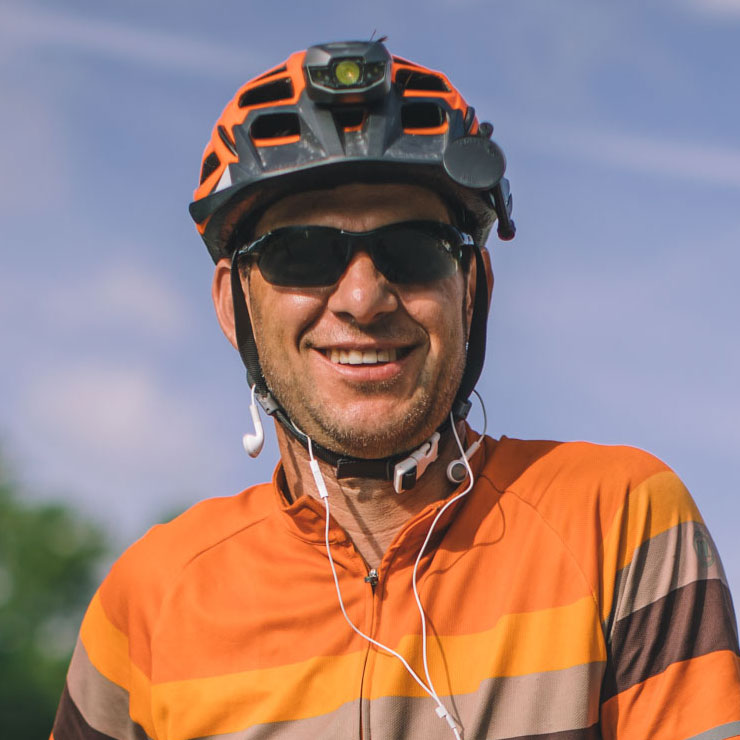
Dylan Taylor
Bozeman, mt.
My mental preparation for the Tour Divide, or any bikepacking race, relies on three things: training, bike/gear, and route research. Showing up in Banff with a solid spring of training behind me, a well thought out and tested bike/kit, and good route knowledge gives me confidence and puts me in a good mental space for the ride.
When training, I don’t follow a strict plan, I just ride a lot of miles and hills in varied conditions, often loaded. There are surely more efficient ways to physically prepare, but that’s what works for me. This is all just a game, after all, and I like to keep training fun.
I spend lots of time agonizing over bike components and kit options, as well as fully testing and tweaking those choices before a race. In optimizing my gear, I focus on balancing weight vs. durability, packing just enough, and making sure contact points are comfortable. Having thought out and used everything on my bike and in my kit, I know that I’ve done what I can to minimize bike and body breakdowns on route.
For route research, I keep things simple, but spend significant time verifying resupply locations, hours, and other vital information that I include on a printed elevation profile. This annotated profile is a nice supplement to the GPX track.
Beyond all that, perhaps the most important mental lessons I’ve learned through participating in 11 bikepacking races since 2010, is to not put an arbitrary cap on goals that may limit my best possible result, to remain flexible, ride my own race, and above all to keep smiling. It also helps that I really don’t mind being dirty, exhausted, and alone, and that I find a unique joy in the extended mental and physical challenge of ultras like the Tour Divide.
Bonus Question: What are the best tires for the Tour Divide?
- Maxxis Crossmark – Neil Beltchenko
- Specialized Fast Trak – Lael Wilcox
- Teravail Sparwood – Jay Petervary
- Maxxis Crossmark – Cricket Butler
- Vittoria Mezcal G+ – Dylan Taylor
Finshed the Tour Divide? What are your secrets for a good ride? Let us know in the comments below!
FILED IN (CATEGORIES & TAGS)
Please keep the conversation civil, constructive, and inclusive, or your comment will be removed.
Rad Companies that Support Bikepacking

You need to be logged in to use these features. Click here to login , or start an account if you’re not yet a member of the Bikepacking Collective…

Tour Divide 2023 Live Tracker
Follow on smart phones with BlueDot App!
Previous / Next / View all
About the Tracker
TOUR DIVIDE GUIDE - BIKEPACKING
YOUR ULTIMATE BIKEPACKING GUIDE TO THE TOUR DIVIDE.
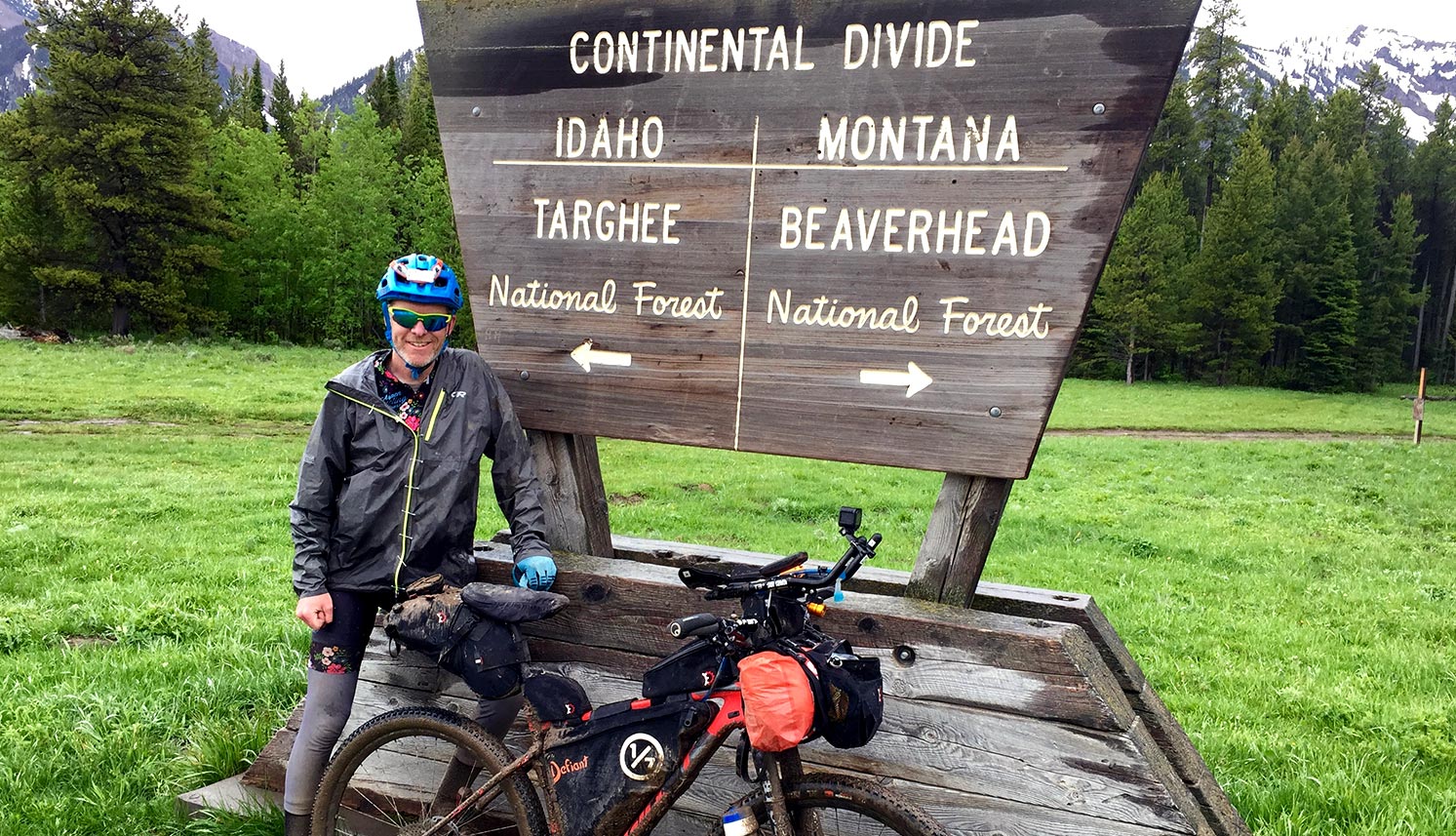
For more information on the Tour Divide visit our TD Resource page . »
Deciding to do the Tour Divide comes with a lot of questions and concerns. I can tell you they’re not as scary as they seem. If you start with a plan and break down the process your worries will change into confidence. Your biggest issue is finding the proper information.
This page is meant to be a simple overview of the Tour Divide. During my own Tour Divide I realized there was a need for a guide covering the route just for bikepackers. This page is broken down into simple sections so you can easily get a feel for the route. It’s also part of a larger all inclusive guide, so you can focus on riding your bike instead of searching the internet for hours on end.
Where do you start? This Tour Divide Guide is a great starting point but if you want to know more, checkout the “TD Resources” button below. You’ll find information on resupply, transportation, gear and more.
Do you find this page valuable?
Shopping with our affiliates helps fund the development of content like this.
Share this entry
- Share on Facebook
- Share on Twitter
- Share by Mail
Tour Divide Rider Survey
The Project conducts an ongoing rider survey to help new riders try to figure out what gear to use on the Tour Divide. Undertaking a ride/adventure like can be very intimidating and the planning can be overwhelming. It’s our hope this survey will help new riders with their planning and execution of their Tour Divide ride, as well as help ensure riders are more properly prepared for their adventure.
If you haven’t taken the Tour Divide Rider Survey yet and would like to you can at the links below.
***Please pay attention to the examples for the questions where you have to type in your answer. If answers are not entered EXACTLY like the example I have to go in and correct them and it also throws off the results. Thanks in advance!
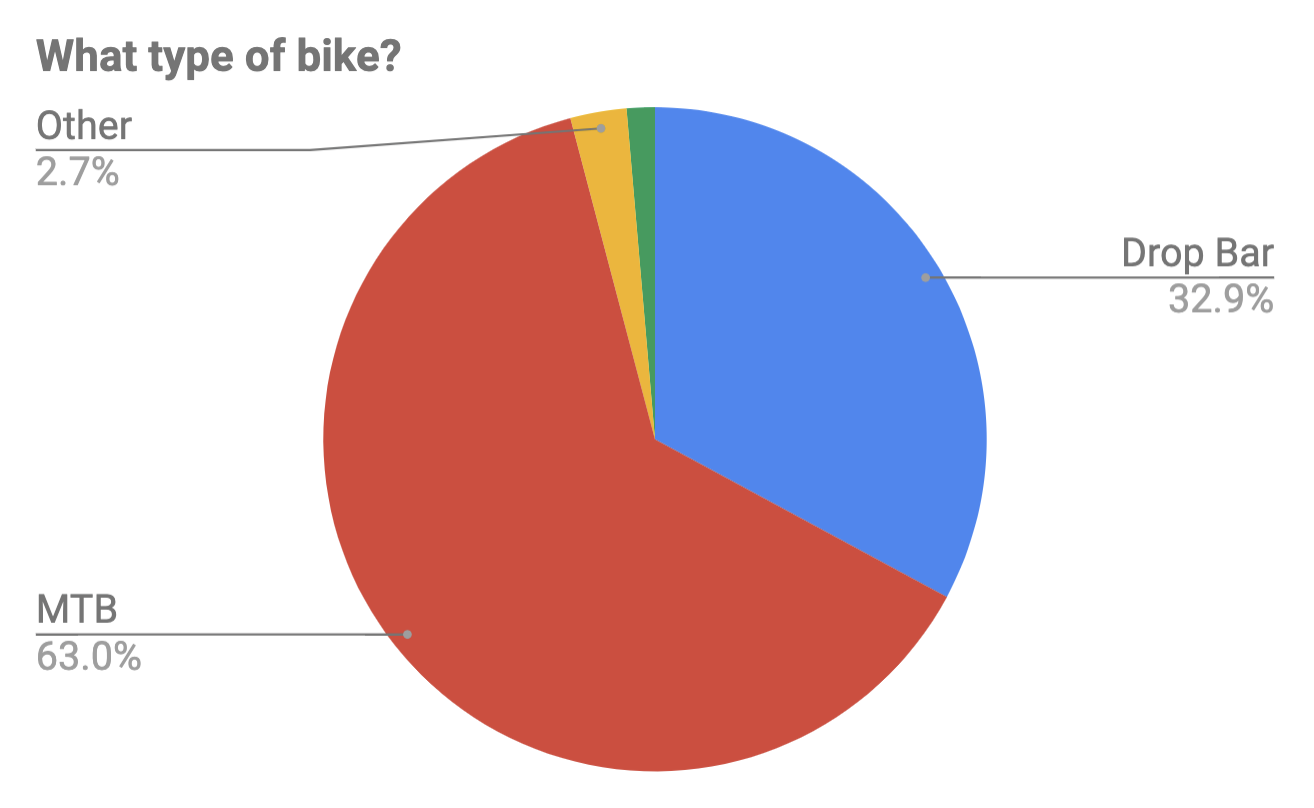
Covers: bikes, suspension, tires & wheels, drivetrain, and Components.
Covers: navigation planning, camping, logistic/travel, clothes, and more.
2745 Miles (4418km)
DIFFICULTY (1-10)
Elevation gain.
200,000 Feet (60,960m)
HIGHEST POINT
11,913 Feet (3631m)
TIME REQUIRED
% singletrack, time of year.
June to October
2nd Friday of June
Closest Towns to Start/Finish
Banff, AB and Lordsburg, NM
Race Record
Male Mike Hall (2016) 13:22:51 Female Lael Wilcox (2015) 15:10:59
The Tour Divide is an 2745 mile route that stretches from Banff, AB to Antelope Wells, NM. The route is roughly 70% off road, consisting of gravel roads, jeep track, and a very small percentage of single track. Traveling through the Canadian provinces of Alberta and British Columbia, and the states of Montana, Idaho, Wyoming, Colorado, and New Mexico, the trails covers a wide range of landscapes.
The route is based off the GDMBR* (Great Divide Mountain Bike Route) from the Adventure Cycling Association , and took four years to map and was released by in 1998. The first ITT of the route was in 2005, while the first Grand Depart was in 2008 (usually held on the second Friday in June). Only a handful of riders attended the first Grand Depart but today close to 200 brave men and women toe the line to test themselves against each other, the route, Mother Nature and most importantly, themselves.
Starting in Banff, AB the Tour Divide winds its way through the Canadian Rockies along glacial rivers and grizzly country. As it travels south the route samples many different types of landscape. In Montana and Colorado you’ll experience mountain wilderness, Idaho and Wyoming offer up grasslands and endless rolling hills, while New Mexico and southern Colorado have high desert. Near the border you are treated one last time with time spent in the Chihuahuan Desert.
Don’t let the fact that the route is mostly dirt roads and lacks technical single track fool you. The attrition rate is 60%. Exhaustion, hypothermia, boredom, and mechanicals are common place on this, the longest bikepacking route in the world.
*The Project doesn’t have a separate resource for the GDMBR but we do off planning aids. You can find them here .
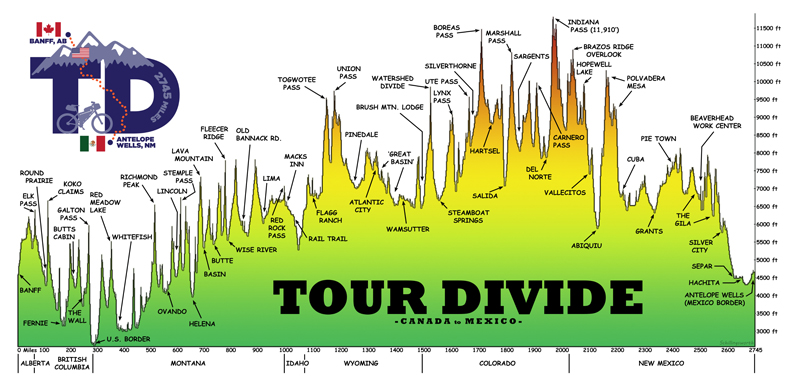
Elevation profiles provided by John Schilling. Support John’s effort by purchasing prints, sticks and mugs of these profiles.
2024 TOUR DIVIDE COUNT DOWN
June 14, 2024
TOUR DIVIDE RACING
TOUR DIVIDE
The Tour Divide is not an sanctioned or organized race in any way. Consequently it’s regarded as large group ride that follows a fixed route, a set time, a set of simple rules and that’s all. Those who partake should understand this and obey the gentleman’s agreement to “race” fairly and follow the rules. There are no checkpoints, race organizers, aid stations or aid of any kind. You’re solely responsible for your own welfare.
The TD starts in the Banff on the 2nd Friday of June. The start is now broken down in waves to help not over crowd the local trail system in Banff. There is usually a neutral roll out and the racing starts when you hit the dirt road just south of the Fairmont Banff Springs Hotel.
Suggested Start Date:
2nd Friday of June (staggered start)
Registration:
Send a letter of intent after winter solstice to [email protected].
Bikepack racing is generally not organized, no entry fees are collected or prizes given out, but there are a general set of guidelines all bikepacking races follow. As a result the rules are designed to create a level playing field for all who decide to participate.
*Note these rules are the general rules for bikepack racing and each event may have their own specific rules and they also change from time to time. With that said it’s important you read and understand the official rules which can be found at the link below.
1. Racers must completely cover the route under their own power.
2. No outside support is allowed.
3. Food/supply caching on the trail is not allowed ahead of time (but one can ship items to a Post Office).
4. Motorized transportation or hitch-hiking, EXCEPT for travel to hospital/medical care, is NOT allowed at anytime.
The following are allowed, but not encouraged. Please use sparingly.
5. Unintended assistance from fellow racers is ACCEPTABLE.
6. Trail magic is OK – but please, no begging or fishing (hinting).
7. Mailing resupplies to Post Offices is ACCEPTABLE.
For full rules visit TourDivide.org .
No entry fee, no prizes, absolutely no support
IMPORTANT RACE INFORMATION
Registration: Send letters of intent after the winter solstice to [email protected].
The GPX file can be found TopoFusion.com , and usually is updated about a week before the start.
In-Race Updates called “Rained Out” are used to update racers of any route changes/detours. Links will be emailed to you (via text message or email for non-US phones).
A Bear Spray discount (15%) is usually arranged in the months leading up to the start. Keep a watch on the Facebook pages for details.
Salsa stem caps are usually available at the start in Banff. You can get yourself a free piece of pie when you get to Pie Town, NM.
SPOT TRACKING
Racers and those touring the Tour Divide are encouraged to carry a Spot tracker, though they are not mandatory. Due to the remoteness and sheer difficulty of the trail I personal believe you’d be crazy not to. Racers can sign up at Trackleaders.com one month before the race if they choose to.
You can rent a Spot from Trackleaders.com around one month before the start of the race (You’ll receive information to your email you used when signing up). Check Trackleaders or Bikepacking.net forums for information at that time.
SUPPORT THE ACA
The Adventure Cycling Association (ACA) has no ties to the race but they did build the route, have created amazing maps and their a great resource . It’s because of them we have this amazing route to race/ride. Please consider joining the ACA. Membership is only $45 and as a member you get all kinds of discounts and other perks, most noteworthy a discount on maps.
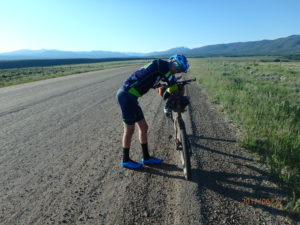
Tour Divide Planning Aids
Being that I’m also a Triple Crown thru-hiker I’m used to quality planning tools. After finishing the Bikepacking Triple Crown I realized bikepacking didn’t have quality planning tools available. The Project’s Planning Aids and Resources are our answer to this.
After 100’s of hours of research, 1000’s of keystrokes, more emails and phone calls than I can recall the One of Seven Project’s Tour Divide Planning Aids are done. They’re the ultimate planning resources for the Tour Divide. They contain everything you need to plan and execute your ride/ride of the Tour Divide and most of the GDMBR. If you can’t find what you’re looking for in these then it’s probably in our Tour Divide Resources .
Craig, I wanted to let you know that your bikepacking guides are incredibly well done and useful.
Small Bundles:
Big bundles:.
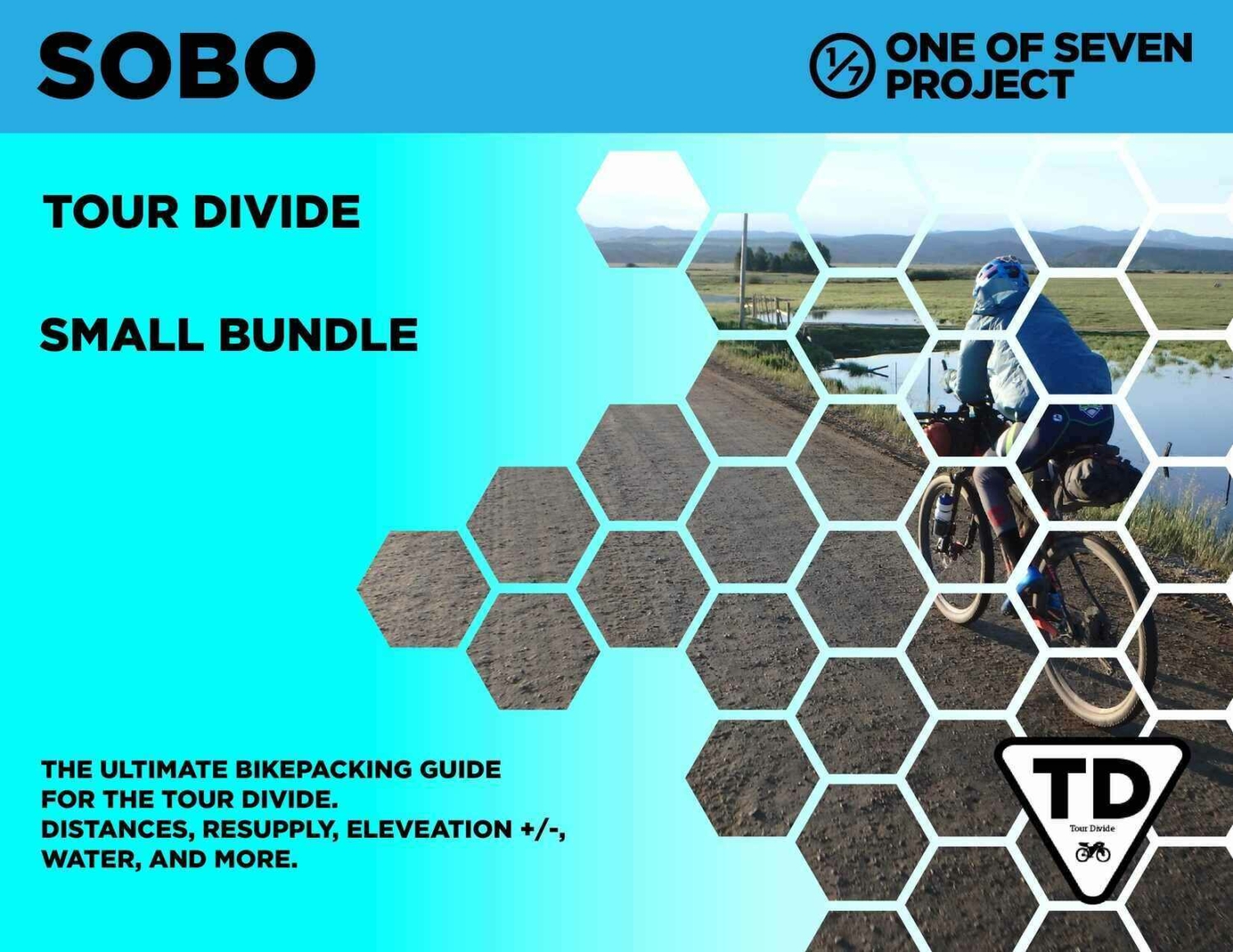
One package including our two most popular planning aids:
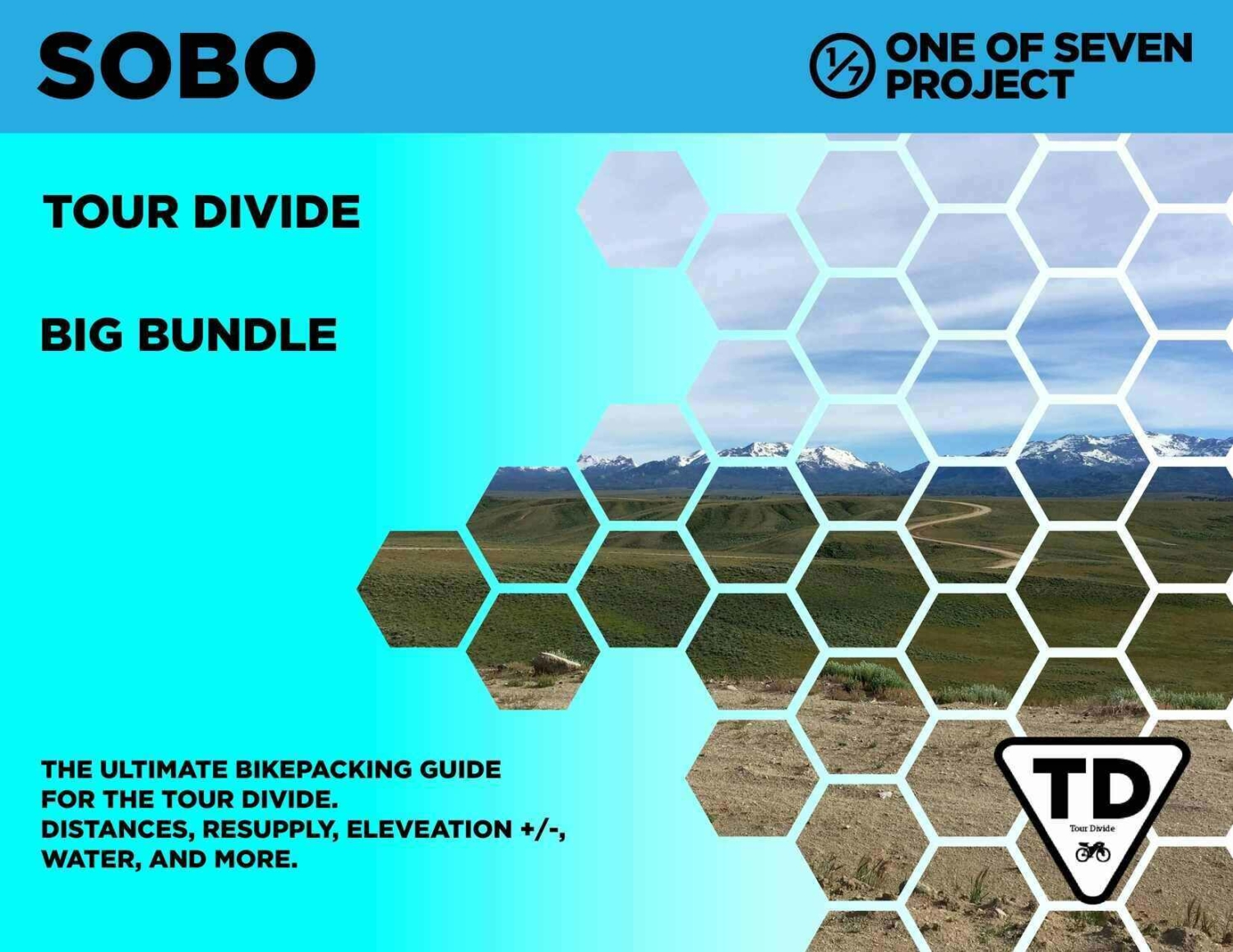
One package with all our planning aids:
- Mileage Chart
- Elevation Gain Chart
Available in both SOBO and NOBO versions and US Standard and Metric units.
Small Bundle – $40.00 + tax (CO only) *You save $10 when you bundle!
Big Bundle – $60.00 + tax (CO only) *You save $20 when you bundle!
Data Sheets and Town Lists
Data sheets:, town lists:.
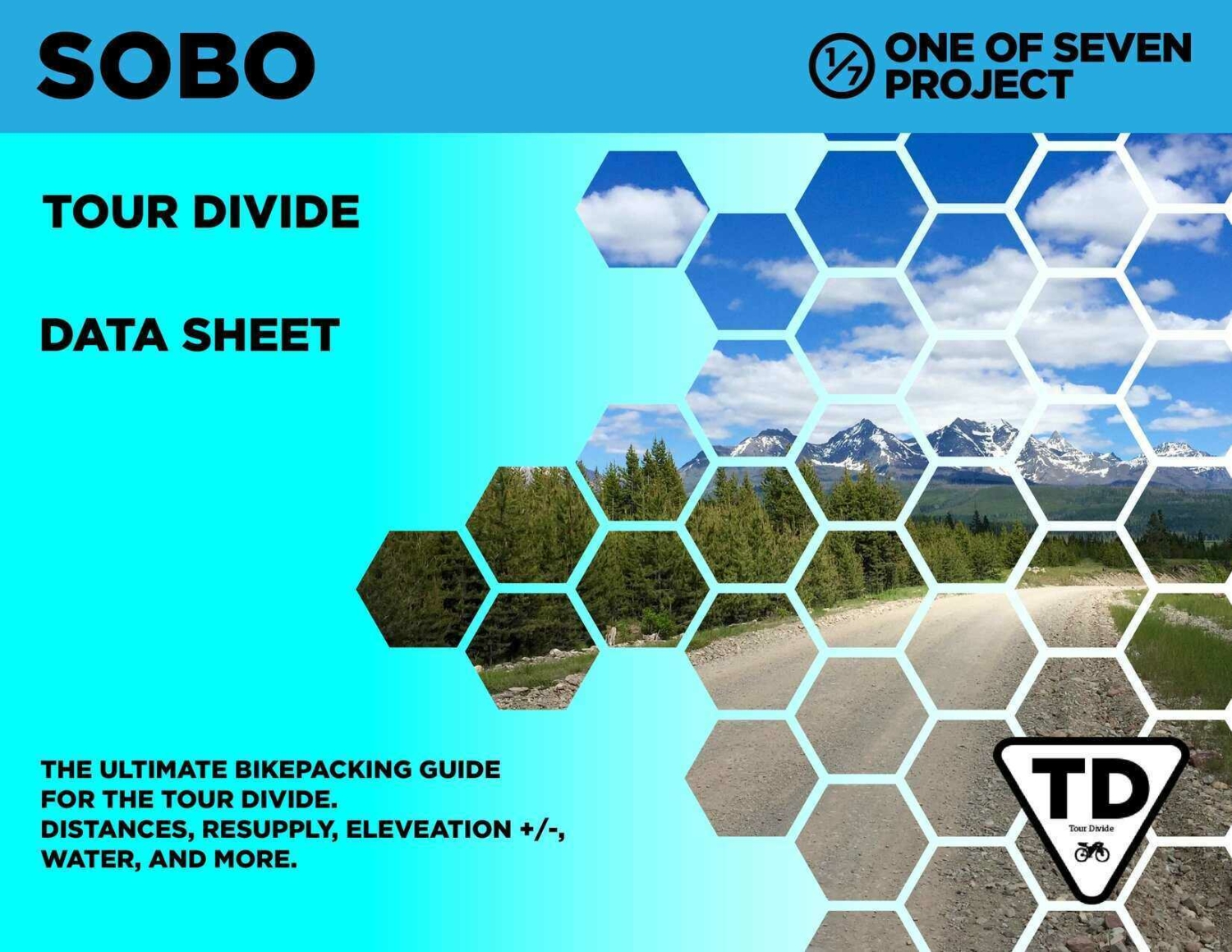
The NOBO Data Sheets are ONLY available as part of the Small or Big Bundles.
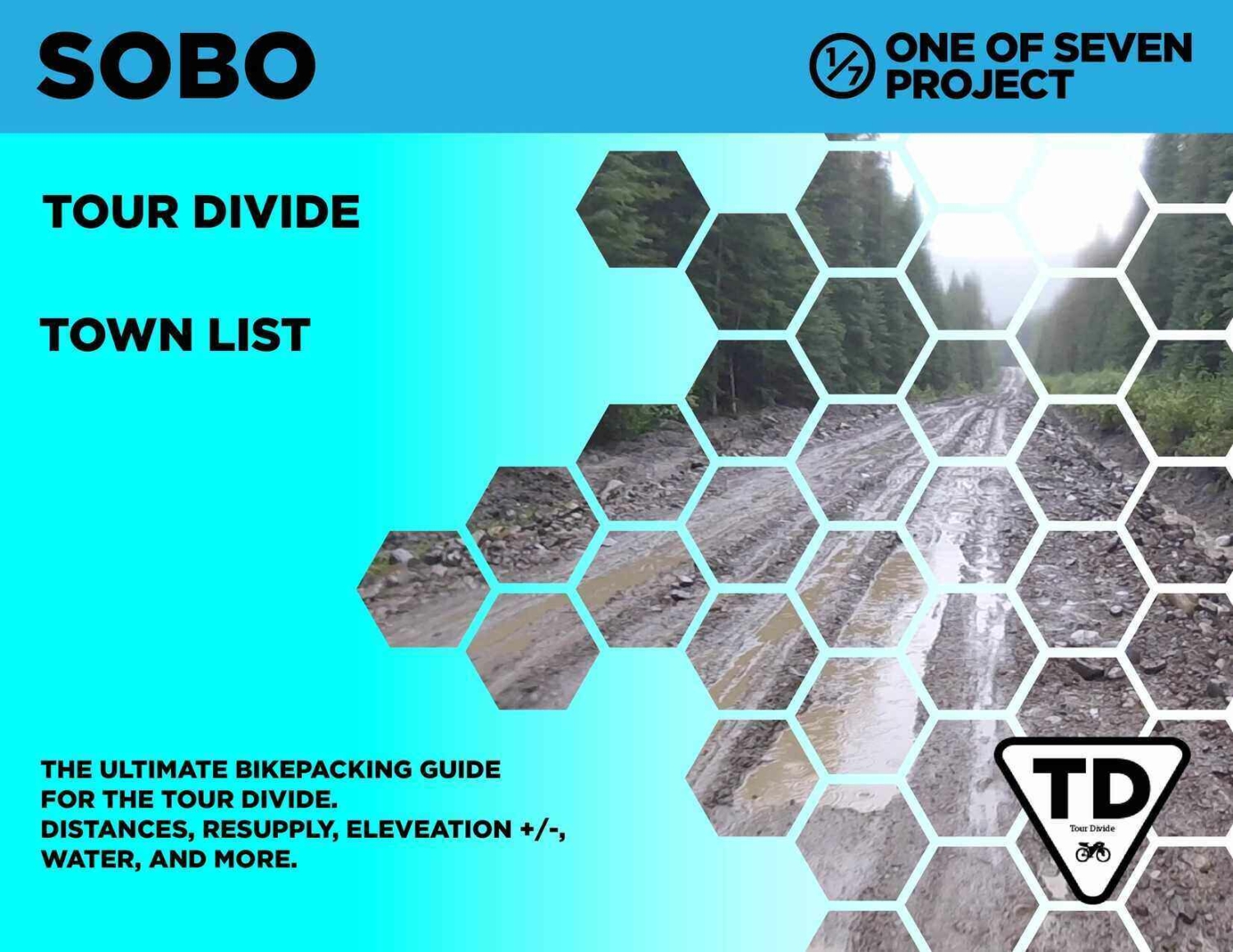
All versions of the Town Lists are ONLY available as part of the Small or Big Bundles.
- Elevation / Pop of POI.
- Mileage numbers.
- Distance to next.
- Elevation +/-.
- Max & Min. elevation between POI.
- Pavement sections.
- Key water sources.
- Shows bike shops.
- Resupply options.
- Important notes.
- Elevation profile.
- Finish Target Times.
- Distance on/off trail.
- Important notes about POI.
- Cumulative distances to up coming POI.
- Elevation Gain to reach up coming POI.
- Finish Target Times added.
The SOBO Data Sheets are available in BOTH US Standard and Metric units.
Data Sheet – $25 + Tax (CO only)
Example of Data Sheet
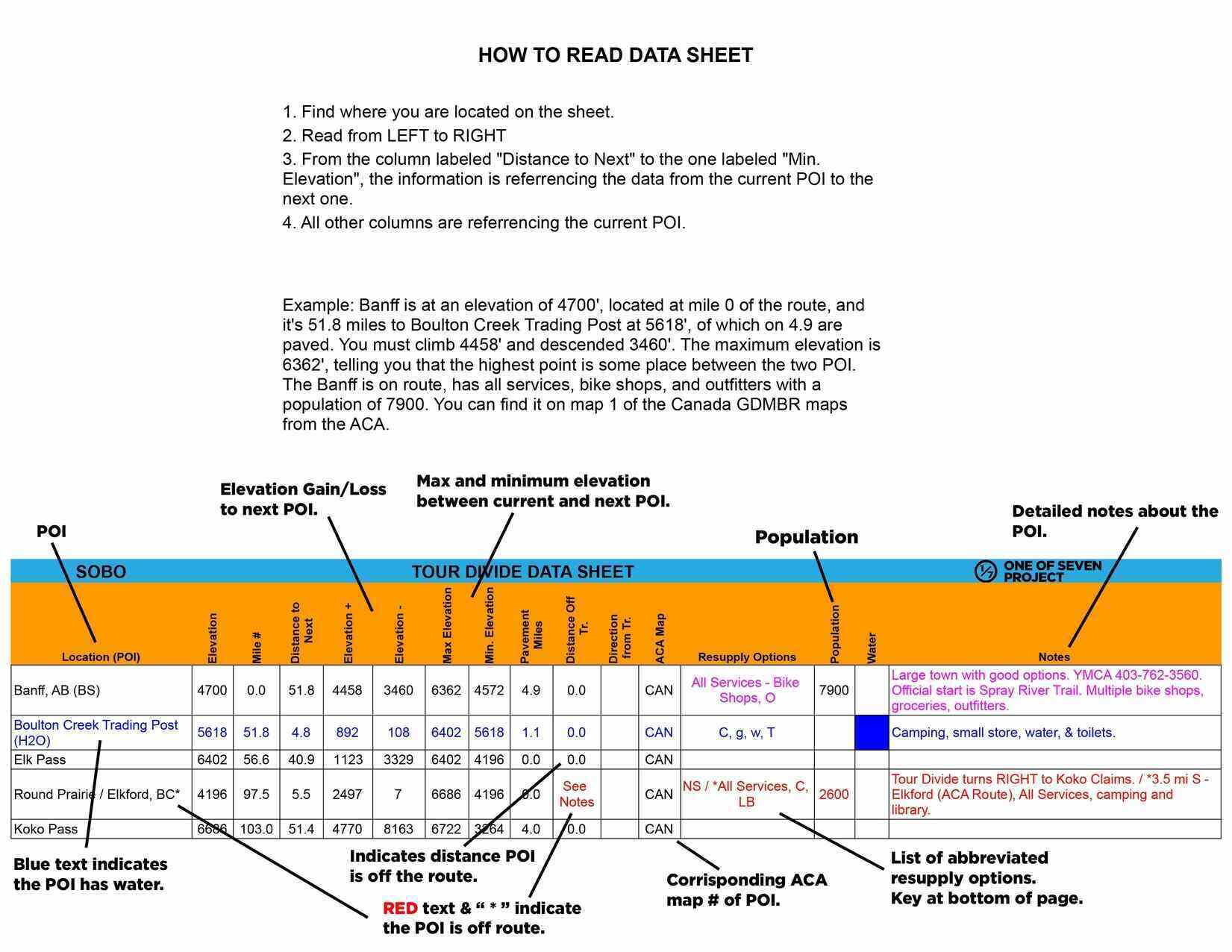
Example of Town List
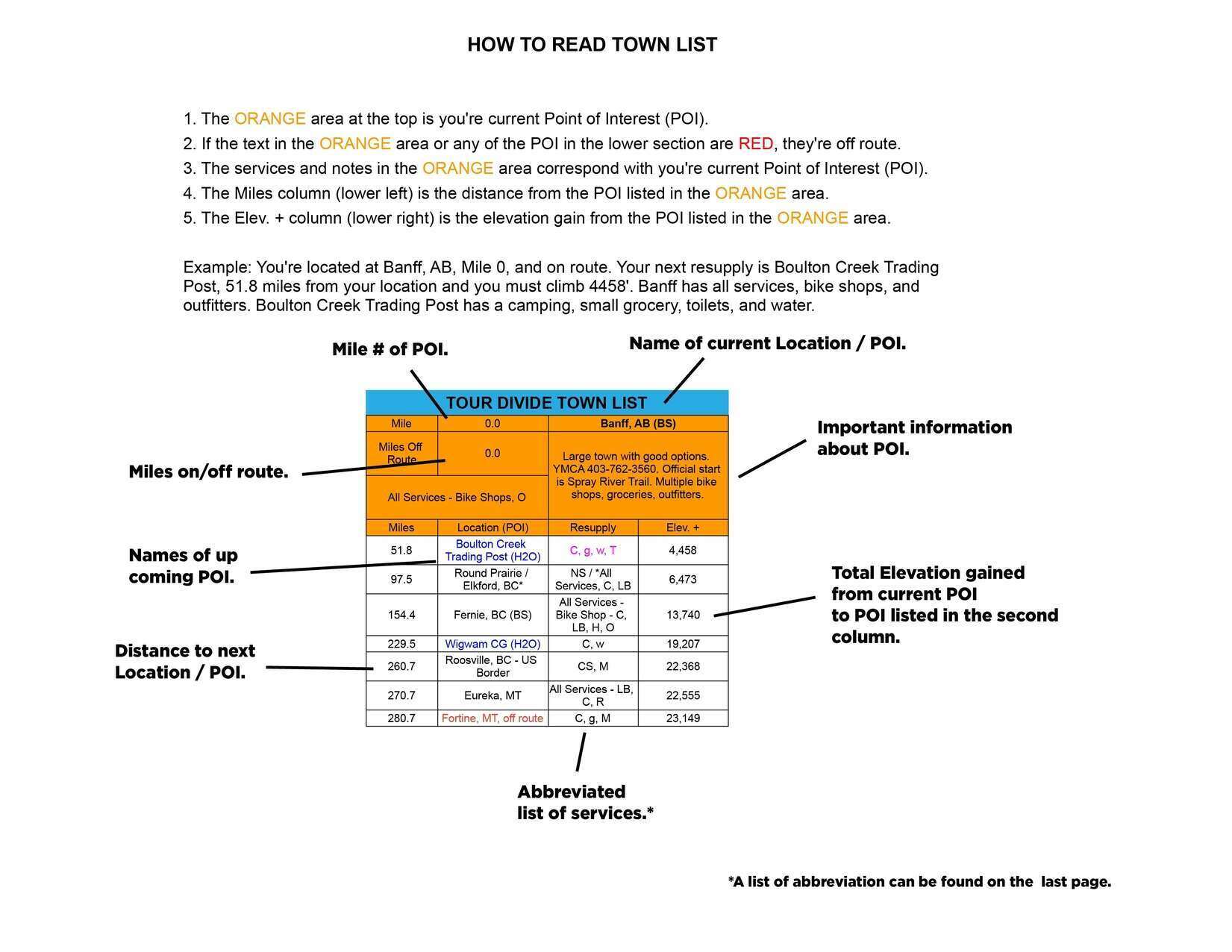
DATA SHEET and TOWN LIST DIFFERENCES
The Data Sheet has the most info. It gives the distance, elevation +/-, average grade, maximum and minimum elevations, pavement sections, references ACA maps, bike shops, resupply options, and has key notes between two POI. Example: A and B, then B to C, and so on.
The Town List gives cumulative distances between POI. Example: A to B, A to C, A to D. The next section would be B to C, B to D, B to E, and so on. The Town List has distance, elevation +/-, resupply options, bike shops and key notes.
The Town List helps with not having to do the math to figure out how far away things are if they’re not the next POI.
Mileage Charts and Elevation Gain Charts
Mileage charts:, elevation gain charts:.
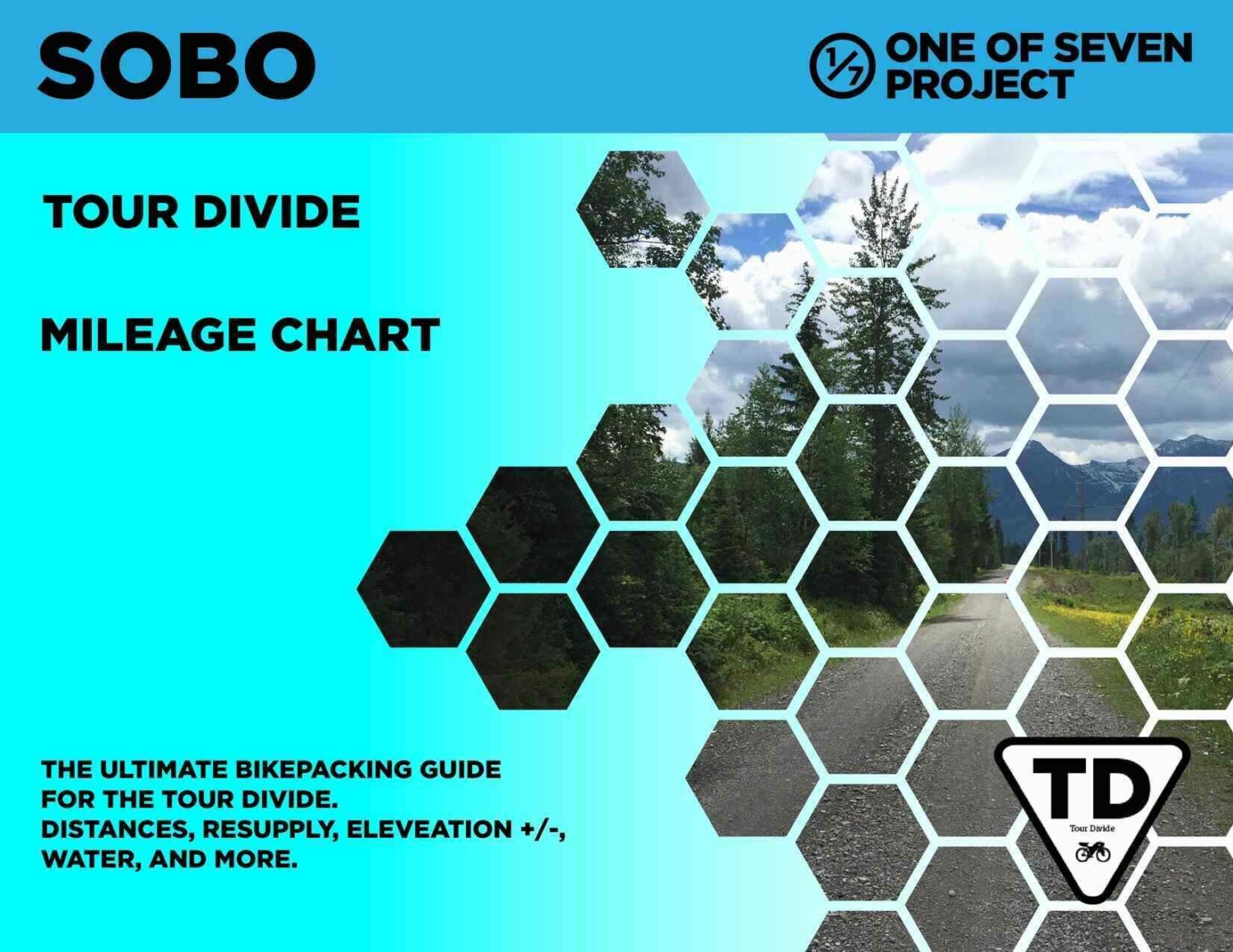
Quickly find the total mileage between any two POI along the route.
- Works for both directions.
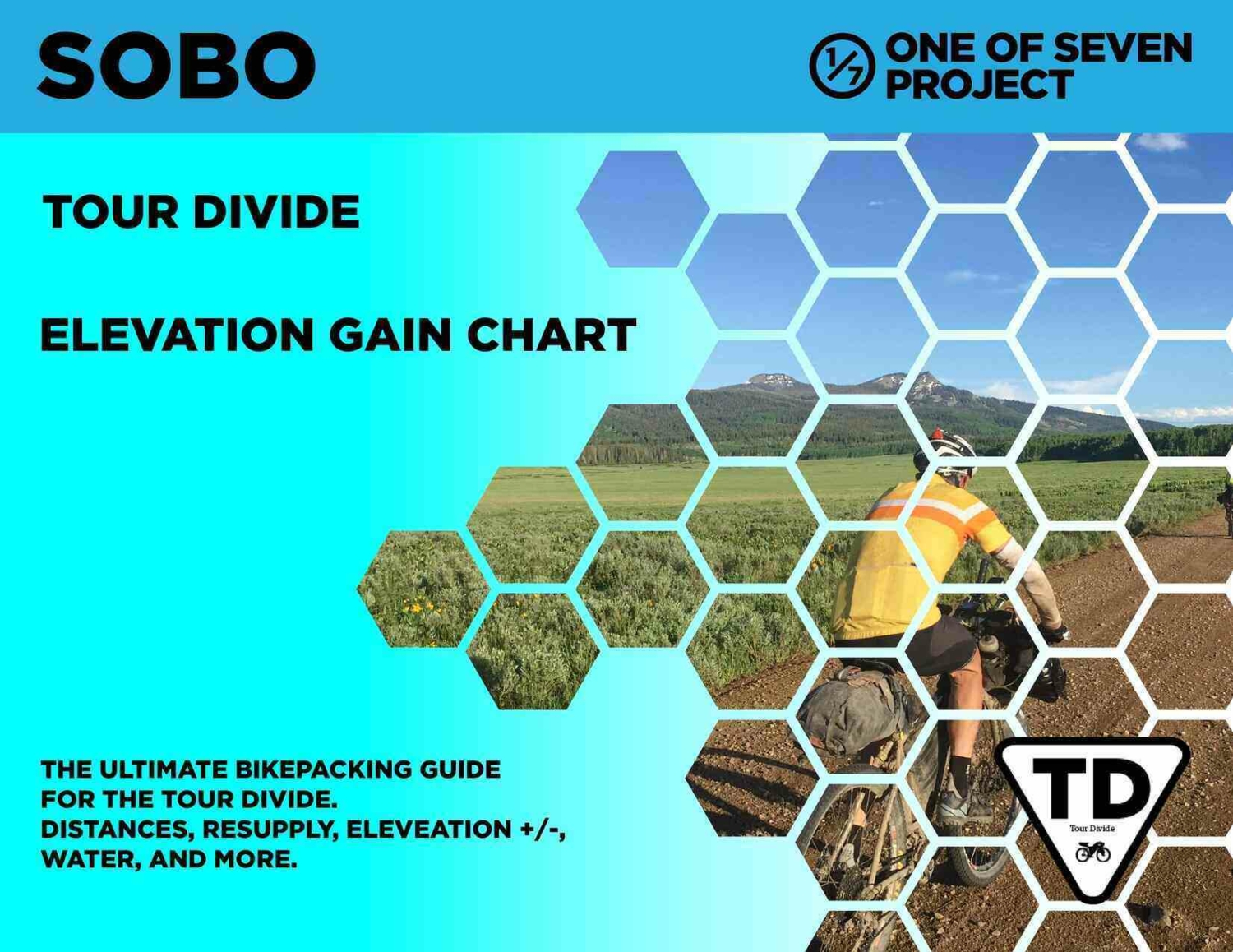
Quickly find the total elevation gain between any two POI along the route.
- Easy to read format.
The Mileage and Elevation Gain Charts are ONLY available as part of the Big Bundle.

GDMBR / ACA ROUTE
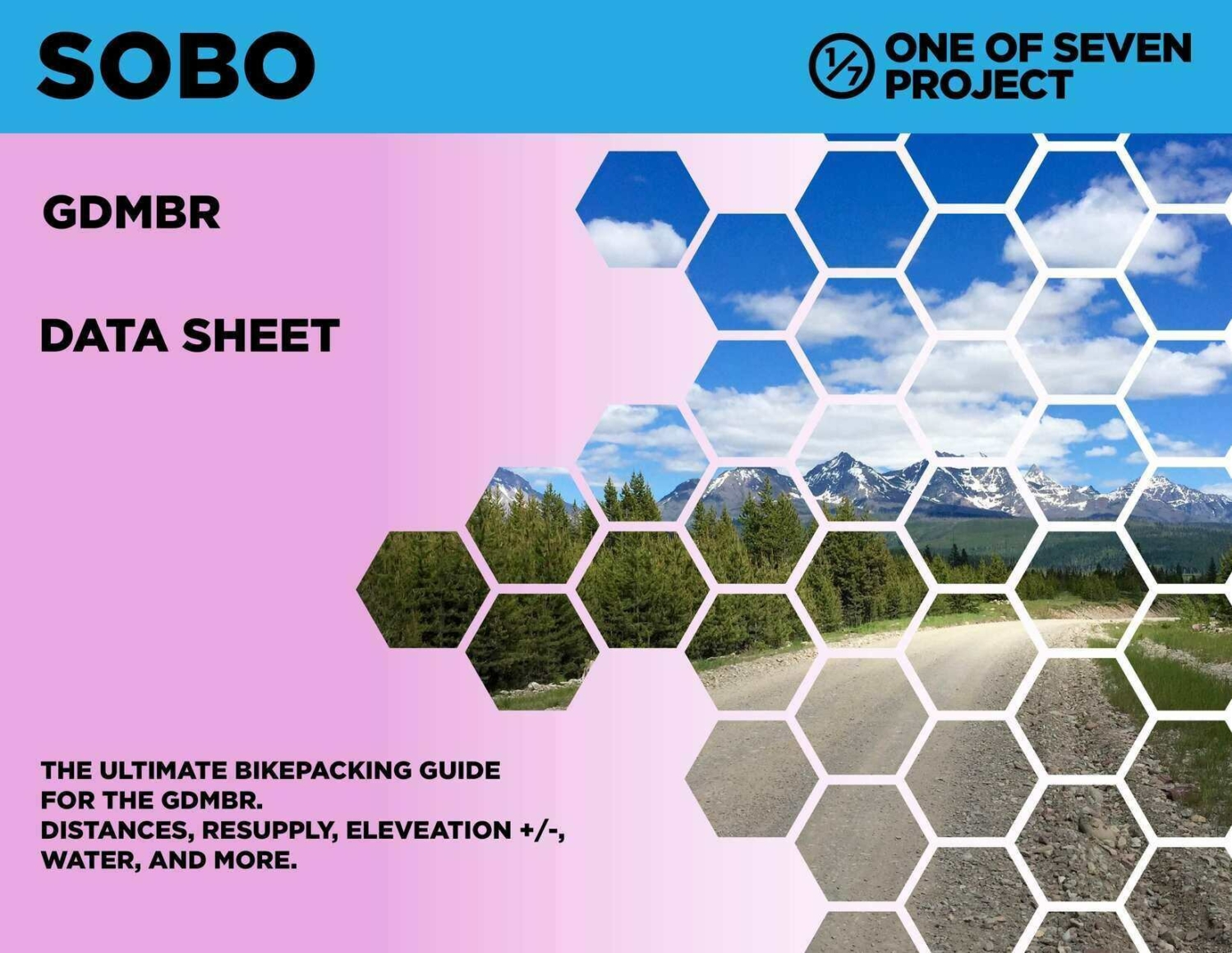
GDMBR Data Sheets have all the same data categories as the Tour Divide planning aids, as seen in the examples above but are for the GDMBR from the ACA.
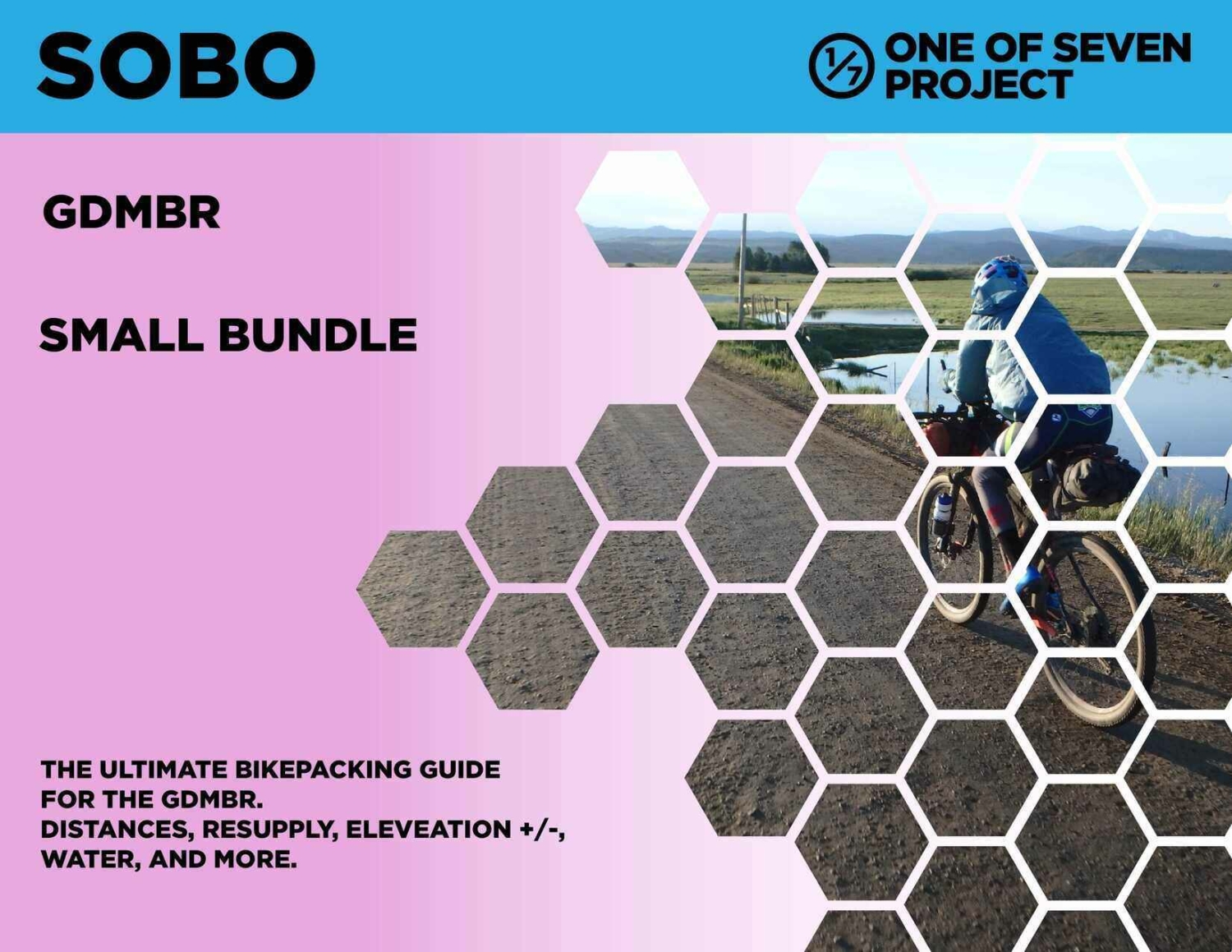
GDMBR Bundles have all the same data categories as the Tour Divide planning aids, as seen in the examples above but are for the GDMBR from the ACA.
Available in both SOBO and NOBO versions and in US Standard and Metric units.
Data Sheet – $25 + tax (CO only)
- The diversity of the route has to be one of the biggest highlights of them all. From the Canadian Rockies, to the Great Basin, to the Rocky Mountains, and finally the deserts of New Mexico you see it all.
- The support from the communities you go through is pretty amazing. Don’t pass up on their hospitality and remember to be polite.
- Some of the top highlights have to be the Flathead Valley in Alberta, Grand Teton National Park and the Great Divide Basin in Wyoming, Boreas and Indiana Pass (the routes highest point at 11,913′) in Colorado, Polvadera Mesa, and the Gila Wilderness in New Mexico.
- The long days and hours in the saddle can get boring. As a result they will test you both mentally and physically. Be ready to be inside your head a lot.
- Limiting your time in town gets harder as you move further along the route. Fighting that voice that say’s “Just one more soda!” or “Just a few more minutes rest.”, can be hard to silence.
- The weather is unpredictable due to the route’s nature. Be ready for all types of weather from rain, snow, hail, wind, lightening and heat.
- There are some segments between towns that are longer than most but none are unmanageable if you have the right bag set up.
- The only two places where water was an issue was the Great Basin and Beaverhead area in NM.
- Camping along the Tour Divide is not hard to find. There are plenty of primitive and developed options for camping, hotels, or lodges on the route.
- There are no areas that require special permits but do be careful to respect no trespassing signs along the route.
- Those touring want to checkout Warmshowers.com .
DANGERS & PITFALLS
- Extreme weather.
- Bears (Grizzly and Black)
- Remoteness of route.
- Lack of water.
- Strenuous terrain.
- Costs can add up.
- Hypothermia
- Riding on roads at night.
- Mental & physical fatigue.
- International border crossing.

PHOTOS OF THE TOUR DIVIDE

EXTERNAL RESOURCES
- BIKEPACKING.NET
- BIKEPACKING.COM
- TOURDIVIDE.ORG
- TRACKLEADERS.COM
- BIKEPACKING.NET FORUM
- FACEBOOK GROUP – Gear, Advice, Tips, Pics, Chat, Training
- FACEBOOK GROUP – 2024 Tour Divide Training & Preparation
- FACEBOOK GROUP – Crazy Larry’s Questions and Answers Session
- FACEBOOK GROUP – Great Divide Mountain Bike Route – Trail Info & Rider Stories
- MTBCAST.COM
MAPS / BOOKS / APPS
- ACA Maps (These maps differ slightly from the official race route, follow your GPS)
- Temporary Closures
- Book – Just Ride
- Book – Cycling the Great Divide
- Book – A Dream Worth Living
- Video – Ride the Divide
- Book – Eat, Sleep, Ride
- Book – Dividing the Great
More Helpful TD Resources
Everything you need to plan a bikepacking trip on the Tour Divide.
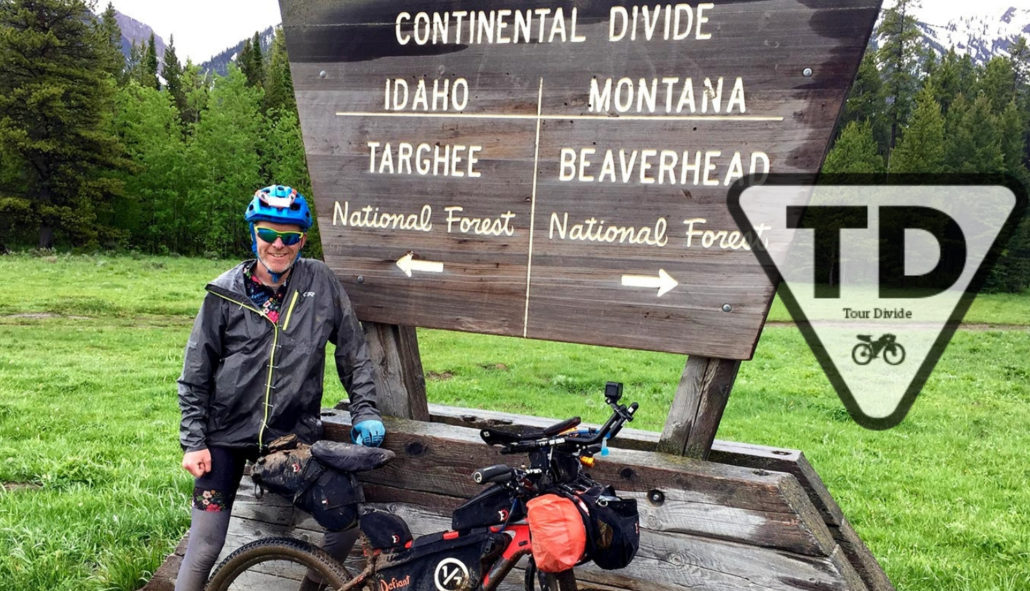
Slide Title
Tour divide guide bikepacking.
Your ultimate bikepacking guide to the Tour Divide.
MY PROVEN GEAR LISTS FROM THE TRIPLE CROWN
Tour divide.
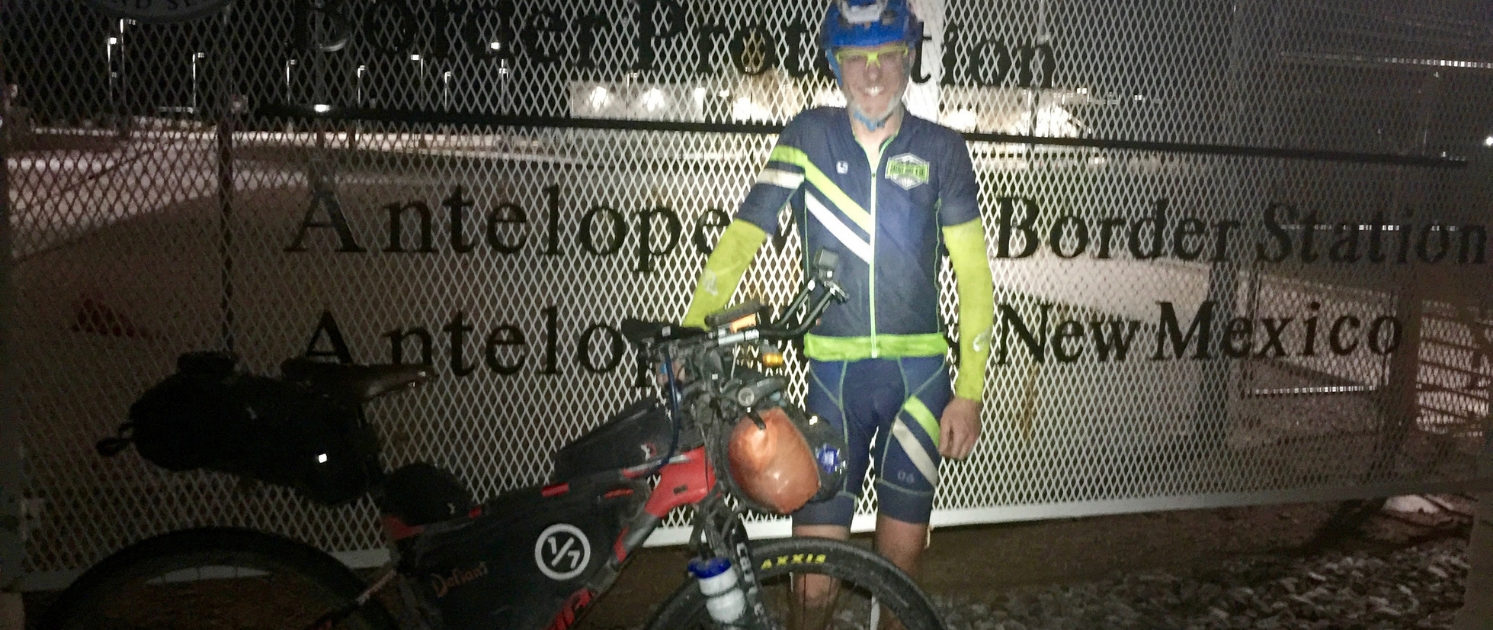
A detailed look at what I used on the Tour Divide, what worked and what didn’t.
“ IF I RODE… ” SERIES
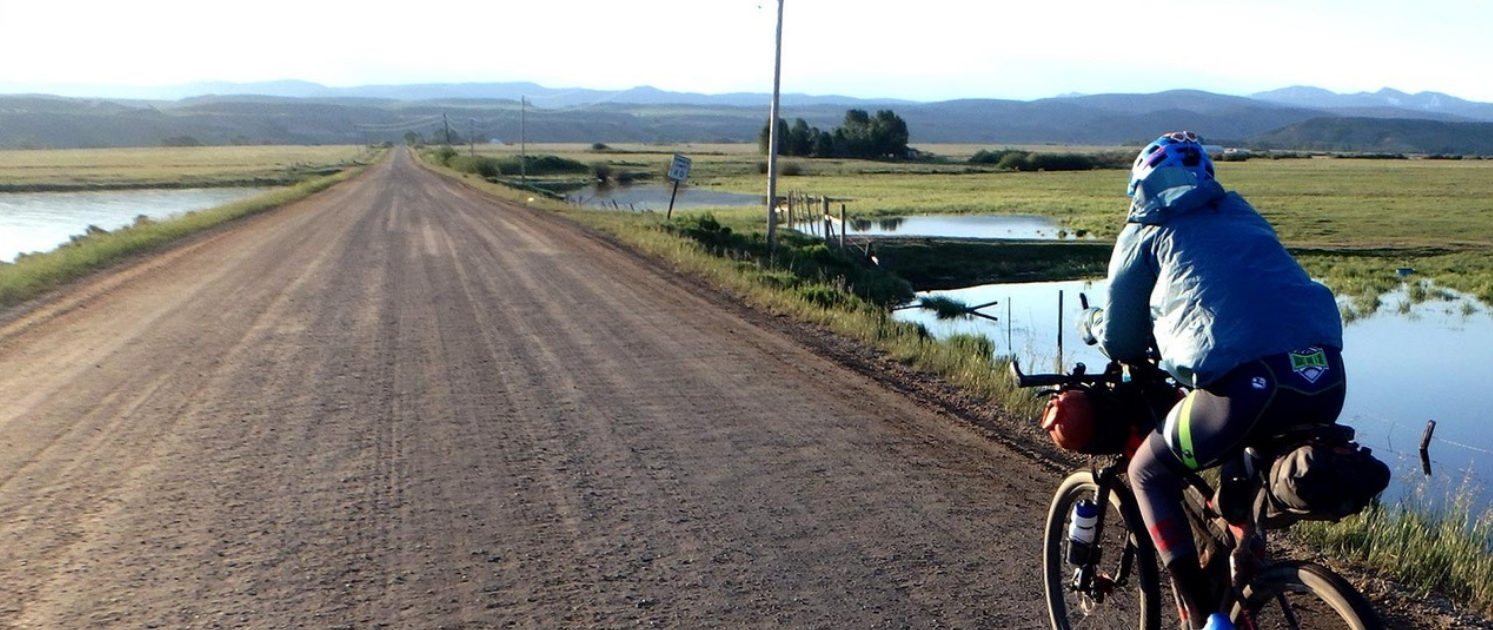
In depth look at what I would bring for gear and why, if I rode the Tour Divide again.
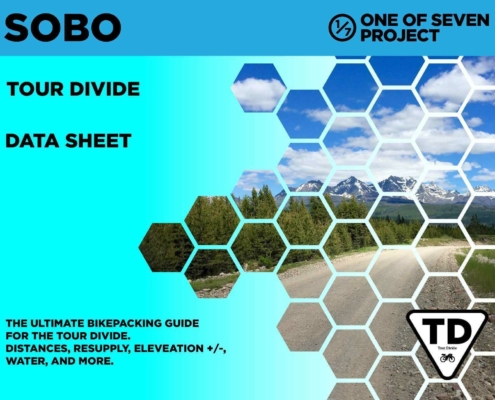
Gear Review - If I Rode The Tour Divide Again
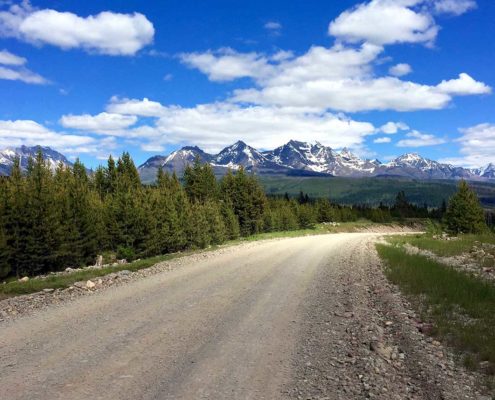
Tour Divide Planning Guide
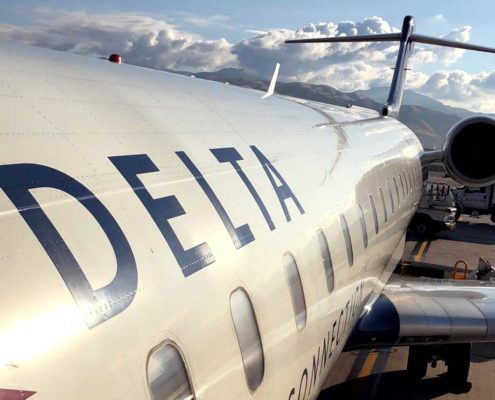
Tour Divide Transportation Guide
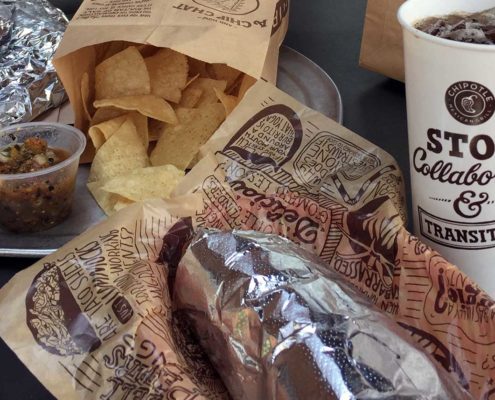
Tour Divide Resupply Guide
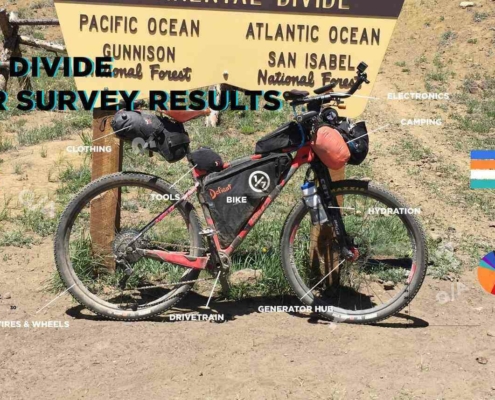
Tour Divide Rider Survey Results
Checkout our bikepacking resource page for more planning help., checkout all our guides.
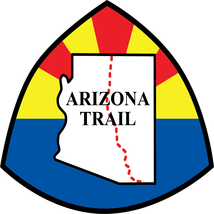
Support the Project
Simply clicking on the links below with our affiliates supports the Project.
Or checkout our Deals page to save big!

Our Thoughts on Getting Outside
Leave no trace principles, recreate responsibly.

Your cart is currently empty!
Touring the Great Divide Mountain Bike Route vs. Racing the Tour Divide
Riding the Great Divide Mountain Bike Route (GDMBR) or racing the Tour Divide is a rite of passage for many bikepackers; it’s seen as the “Big One” in North America. Stretching 2,745 miles from Banff, Alberta to Antelope Wells, New Mexico, it loosely follows the Continental Divide through the Rocky Mountains on a series of dirt and paved roads. The fastest men can complete the route in under 14 days, while most people who tour it take six to ten weeks.
In 2018, I had the opportunity to tour the Great Divide Mountain Bike Route (GDMBR) with my husband Andrew Strempke. While we initially were attracted to racing, the rules of the event require solo, self-supported travel, and we wanted to ride together. And so we did, completing the route in 25 days. Four years later, in 2022, we both lined up to race the Tour Divide with the intention of completing the route within the constraints provided by the event. While we weren’t going to go out of our way to avoid seeing each other out on the route, the reality was that unless something went very wrong for Andrew, the chances of us riding near each other was fairly minimal.
Touring versus racing the route yielded two vastly different experiences. Racing tends to be more glorified by other people, but touring was just as satisfying, and in 2018, I believe it was the better choice for me at the time. There are benefits and drawbacks to each style of trip, and I feel lucky to have been able to experience both.
Rules, What Rules?
While the Great Divide Mountain Bike Route is open for anyone to ride under any style, signing up for Tour Divide means that you’re agreeing to pedal your bike from Banff to Antelope Wells in a self-supported solo fashion following the route mile for mile. On the other hand, touring provides the freedom to accept assistance from anyone, to share gear with as many people as you want, ride as fast or slow as you desire, and to detour around impassable roads or sections of the route that you’d rather not ride.
Touring: There are no rules! Choose your own adventure! The biggest determining factor that caused Andrew and I to choose touring over racing in 2018 was the Tour Divide’s rules about riding solo and self supported. Completing the route together was more important to use than officially completing Tour Divide. Andrew and I rode side by side the whole time, supported each other during low points, and kept each other entertained. We split gear to lighten our loads and deviated from the route a couple of times when following the route would have meant pushing through hours of mud, something we preferred to avoid whenever possible. We did want to complete our tour under our own power, so we didn’t ever get into a vehicle with the exception of a short road section that was under construction. The workers required us to take the pilot car until the end of the one-lane section of road. There was no one to question whether taking that ride in the pilot car invalidated our ride.
Racing: When I signed up for the Tour Divide, I agreed to abide by the rules of the race. There aren’t many, but the gist is that you agree to follow the entirety of the route in a solo self-supported fashion. With so much rain this year, making a turn onto a road I knew would be a sloppy mess when there was a perfectly good paved road that parallels the route was a bummer at times. That being said, knowing I was following the same route as all the racers, facing and overcoming similar challenges, and finding ways to make it through challenging conditions was rewarding in the end.
Riding self-supported also means carrying your own gear. When my dynamo light broke and I knew I’d have to spend more time charging electronics in towns, another racer offered me his extra battery pack and a light. While racer-to-racer support is typically tolerated, this definitely felt like a gray area and seemed a lot like sharing gear, so I chose to decline the offer, even though it would have saved me time.
Following the rules challenged me to solve my own problems and be mentally flexible when unexpected issues arose, which helped me to grow in my confidence as a bikepacker and solo woman traveler.
Counting Grams, Optimizing for Safety
The main difference in my gear between racing and touring was due to the fact that I couldn’t split the load with anyone during the race. Since I was going solo, it was important to maintain all of my own gear. I also had to be confident in using everything I carried. I wouldn’t have Andrew’s light or utensil or jacket if something happened to mine.
Touring: As we prepared for our tour, we decided we wanted to go light. We went with a minimal setup with no stove, no extra camp clothes, and one set of riding clothes. We split tools, a first-aid kit, and a two-person tent. Since we were on a 30-day timeline for our trip, including travel to and from the start, we had to cover ground quickly, and minimizing the weight on our bikes made a significant difference in the speed we could travel. The fact that we were able to share gear meant my load was actually lighter on the tour than it was racing.
Racing: When choosing gear for a race effort, it’s always a balance of being as light as possible while still being as safe as possible. I made some gear changes based on what I learned from the tour and my additional bikepacking experience. On the 2018 tour, I brought a 30-degree quilt and a foam pad and found myself too cold a few nights. For the race, I upgraded to a 25-degree sleeping bag and an insulated air pad. This setup actually ended up being too warm for most of the race and I woke up several nights in a puddle of sweat and drool, but it gave me confidence that I would be warm despite the wet and cold weather. I also brought more substantial rain gear after getting rained on during our tour in 2018 and finding that ultralight rain gear just doesn’t keep me warm or dry enough. I also chose to use a synthetic puffy rather than a down puffy. Synthetic insulation stays warm when it’s wet and down does not, but it also doesn’t compress nearly as effectively. I anticipated being soggy from rain or sweat for at least part of the ride, so the trade-off was worth it. I made sure all my tools worked and that I knew how to use them to fix common mechanicals.
Optimized for Speed…or Enjoyment
When people hear “touring,” they tend to automatically think you’re going slow and bringing the kitchen sink. That wasn’t the style of tour we were interested in, though plenty of people do that too. During our tour, we rode fast, but took it slow in towns to eat lots of food and get plenty of rest. In the end, my race pace was several days faster, not necessarily because I actually rode faster, but mostly because I just rode longer and stopped for as little time as possible, rushing through resupplies and meals.
Touring: Andrew and I completed our tour in 25 days, which is a pretty quick pace for a non-race effort. It felt good to challenge my body to go hard and cover ground quickly. I loved riding my bike all day and anyhow, we were on a timeline. Despite having a deadline to be back, not having the pressure of racing allowed us to slow down without guilt. One of our favorite stops during the trip was the Llama Ranch in Montana. We arrived in the afternoon and spent the rest of the day visiting with the owners Barbara and John rather than pushing on until dark. Later in the route, we stopped at Brush Mountain Lodge for several hours in the middle of the day where we ate pizza and drank beer, sitting and chatting for a few hours before continuing along the route. Being able to stop and spend time with Kirsten, who runs Brush Mountain Lodge was special, and she has become one of our best friends since then. Even though our tour took longer than the race for me, it was certainly not easy. No matter the pace, the Divide route will kick your ass some days.
Racing: My finish time during the race was 19 days and 16 hours. I probably didn’t actually ride much faster, but I rode longer each day and minimized stop time to complete the route in less time. Optimizing stop time and systems is one of my favorite parts of racing. It feels like free speed when you can get in and out of town or set up and tear down camp efficiently. I’ve tried to figure out exactly why I like bikepack racing and I honestly don’t have a great answer. I love challenging my body and the camaraderie of the other racers. I like making decisions under pressure and being forced to rely on myself to solve problems. Crossing a finish line knowing that I used my body and brain to the best of my ability to traverse an established route as fast as I could is a rewarding feeling.
Following The Route…Or Not
The Tour Divide route and the Great Divide Mountain Bike Route have some minor differences. When we were touring, we followed whichever one made sense at the time and deviated a few times when it made sense. When I chose to race, following the Tour Divide route mile for mile was required.
Touring: Making route choices was something extra we had to think about on our tour. We had the freedom to choose where we’d ride, but we also had to take responsibility for those choices if things didn’t work out. Our first detour from the Tour Divide route was around the hours-long hike-a-bike up Koko Claims in British Columbia, Canada. We had done zero hike-a-bike training and figured the risk of injury using untrained muscles wasn’t worth it. We talked to a local mechanic in Banff and he confirmed that going through Sparwood was a better choice for us and even gave us recommendations to take some new singletrack that paralleled the Great Divide Route. We had a blast on that section of trail and when we rejoined the route in Fernie, we saw racers with mud-covered bikes and bodies. Andrew and I looked at each other and agreed that we made the right call.
We didn’t escape every opportunity to hike through mud, though. Our longest mud stretch was on the legendary Bannack Road. We hiked for miles with our bikes on our shoulders or backs when rolling our bikes meant the tires collected mud and became bogged down in seconds. After encountering another rider at an intersection who told us the next section “was like something out of a nightmare” with more mud, it was an easy decision to take a paved short-cut into Lima. We agreed that detouring around long hike-a-bike sections with mud would help us maintain our sanity and have more fun on our trip. Detouring around spots that promised only suffering and misery didn’t make me feel any less like a route finisher at the end, but it definitely made for a more fun experience. I felt successful just getting from Banff to Antelope Wells under my own power.
Racing: To be a Tour Divide finisher, I was required to follow the published race route exactly. The times I went off route for supplies, I had to re-enter the route at the same point I left it. A wrong turn meant I would need to go back from where I deviated from the route to correct the mistake. When it was raining going over Togwotee Pass, I had to make the turn onto the notoriously muddy Brooks Lake Road to hike and ride through slop and snow instead of detouring on the paved road that paralleled it. When I’d toured the route, I’d taken the detour, so I knew exactly how nice the pavement was while I was trudging along at a mile an hour.
Participating in the race made route decisions easy. I just followed the line on my GPS and hiked when I needed to. If I wanted to finish, I had to stay on route. Since detouring around slow or potentially dangerous situations wasn’t an option, I also had to consider weather forecasts and my timing carefully.
During the tour, we didn’t really care how long resupply stops took. We typically sat down for a meal in a restaurant at least once a day and drank local beers. While I was racing, efficient resupplies were important. Limiting stop time is free speed and since I was demanding so much of my body, I didn’t drink beer along the way.
Touring: On our tour, we ate well and neither of us lost weight. Missing restaurant or grocery store hours didn’t mean we needed to keep moving to the next stop or eat a gas station burrito for dinner, we could just… wait. The pace of our resupplies was relaxed. We often took two-hour lunch breaks at restaurants and leisurely walked down the aisles of a grocery store or gas station until we had everything we needed. Salida became one of my favorite towns on the route after eating a huge barbecue Hawaiian pizza and salad at Moonlight Pizza and Brewpub. We slept in a hostel there and stayed up late talking with Continental Divide Trail hikers and other travelers. Our huge meals at cafes and conversations with both locals and other bike tourers added to our experience and gave us a flavor of the communities we were passing through.
Racing: Logistics and efficiency can be an interesting puzzle to figure out during a bikepacking race. Riding later into the night meant that hitting towns during business hours was more challenging. Before the race, I studied the towns and added business hours to a spreadsheet. I was aware of the times I might need to stock up on more food if I was going to potentially miss the next resupply.
When I was a few miles from a town, I would pull up my spreadsheet where I had calculated the distance, estimated time, and estimated calories needed to get to the next stop. I would start making a list in my head of the foods I wanted to get. “Potato chips, candy bars, some kind of gummy candy, pastries, burritos.” You know, all kinds of healthy stuff. I would run over that list in my head, picturing where I might find those things in the gas station or grocery store I was headed to. When I arrived at the stop, I would immediately start looking for an outlet if I needed to charge my electronics, then I would go into the store with my phone calculator in hand. I would walk down the aisles putting food into my basket, adding up the calories until I had enough. Then I would focus on the meal I wanted to eat right then. Normally a vegetarian, I made some exceptions to my normal diet, eating chicken at times when I couldn’t find another good protein source in a gas station.
I ate while I packed up my bike instead of sitting down at a restaurant with one exception. I arrived in Sargents, Colorado, feeling nostalgic. It’s where the Western Express ACA Route crosses the Great Divide Mountain Bike Route. Having been there with Andrew both on our cross-country tour in 2012 and our 2018 tour got me all sappy and I felt like I needed to sit down, reset, and get some real food in me.
Companionship or Solitude
I feel lucky to have shared the Great Divide Mountain Bike Route with Andrew. We made countless memories that we still reflect on today. During the race, I found companionship, but my time with other racers was brief and I spent most of the ride by myself. This might sound lonely, but I also really value alone time and moments spent by myself in beautiful places can be equally as moving for me as moments in those places with another person.
Touring: Andrew and I rode the entire route side by side. It was really special to have shared the experience with the most important person in my life. We were in tune with each other’s needs, moods, and when to provide a gentle reminder that maybe the other needs a snack. When conditions were tough, we kept each other’s minds busy by playing 20 questions. We made decisions as a team about where to stop for food and where to camp for the night. We had both of our brains to deal with mechanicals and make decisions about any reroutes.
In general, riding together tends to be slower. You’re going whatever pace the slowest person at the time is going and end up taking more breaks since you’re dealing with two people’s needs. We typically rode about the same pace and if one of us needed a break, the other was patient. We both wanted the other to feel good and enjoy the ride.
Andrew and I are fortunate that we get along really well, but we did have our moments. I know that Andrew was pretty upset with me when I lost my rain jacket on a rough descent one day just before sunset. (I have since learned that everything that I want to keep goes in a zipper pocket). He sprinted back up the road to go find it while I rode much more slowly behind him. Fortunately a kind racer picked it up so he didn’t have to ride too far up the climb. Then there was the time when Andrew insisted on taking photos of the Montana/Idaho border sign in a thunderstorm. As someone who hates thunderstorms, all I wanted to do was ride down the pass and became increasingly frustrated as Andrew insisted on taking several selfies.
Racing:
While the Tour Divide is set up to be ridden solo, many racers end up forming small groups to ride with. While I rode mostly alone, I did have some time riding alongside other racers, typically for a short time. I would see other racers in towns and when we took breaks. Spending time with people briefly once a day was enough social interaction to keep me sane. I’m a pretty introverted and independent person. Extensive alone time doesn’t bother me and is something I look forward to. Still, every time I would run into my good friend and fellow racer Zack, who was also on a singlespeed, we would chat and share a few miles. The emotional boost provided by those interactions was undeniable.
Andrew was also racing the Tour Divide this year. We anticipated not seeing each other unless something went wrong for him. We agreed not to communicate about the race at all while we were out there. We sent a few voice memos with funny stories. I told him about the time I ate jalapeño chips and they went down the wrong pipe and I gave myself a bloody nose coughing them back up. We promised to not say, “I miss you,” because it just makes us both sad. But I did miss him, and being alone definitely reminded me how much I love Andrew, my friends, and my family.
One of the hardest moments during my race was leaving Brush Mountain Lodge. Kirsten wasn’t planning to be there during the race, but she was. I had already stopped in Savery just 15 miles down the hill for an hour, so I didn’t have more time to spare to spend time with her and my good friend, Jolly, who was helping at the lodge. I left in tears, wishing I could have stayed. I was comforted by the thought that I could come back to the lodge after I was finished.
Traveling solo meant that I generally had to deal with my fears alone, but after a particularly scary lightning experience outside of Pie Town, I was glad to be able to decompress with other bikepackers and hikers at the Toaster House in Pie Town. Just a few miles out of town, I’d felt electricity running through both of my hands through my handlebars and jumped off my bike and got under a small clump of juniper trees. I set up my tarp to stay dry and sat in the lightning position until the storm passed. I was pretty hysterical. After that, I decided to stay at the Toaster House in Pie Town. I felt like I needed indoor accommodations and to talk to other humans to feel okay to go back out into the elements the next day. Jefferson, the host, made a hot meal for me, the other bike tourers, and the CDT hiker staying there. I spent a lot more time talking with them than I normally would have during a race. Talking about our experiences on the route and what life is like outside of bike touring and racing helped me to reset and calm down.
Outside of the emotional support of companionship, I had to be confident in my ability to fix my bike, make good choices in a fatigued state, and be safe on my own. I haven’t always felt confident bikepacking solo, but as I’ve gained more experience I’ve become more comfortable. One of the only times I felt weird being alone is when I saw a man on the side of the trail who was loading a gun. He asked, “Are you alone?” I went ahead and told him that there are other riders right behind me, which is my typical answer for any man who asks me that question.
Sharing the Experience
I wanted to document both our tour and my race. It’s so easy to forget little details if you don’t record or write them down. Documentation takes extra effort, but I’m happy that I did it during both trips.
Touring: On our tour, I laid in my sleeping bag and typed out a blog post with pictures from my phone every night so that our friends and family could follow along, and now I can look back and remember something from each day of the tour. Andrew also took an action camera and made a video about our trip. I found that we were less likely to record our low moments riding together since it’s a bit rude to put a camera in your partner’s face when they’re having a bad time.
Racing: Documenting my race was important to me. I carried a GoPro and posted occasional Instagram stories. Race documentation by outside media crews during the Tour Divide has been met with controversy in recent years, so aside from wanting the footage for myself, I wanted to show that there is a self-supported way to tell my story. My Instagram stories and GoPro footage is certainly not as beautiful as a professionally documented film, but it’s raw and I like it that way. Most of my documentation was done while I was pedaling, and I put together the GoPro footage when I was recovering after the race.
It’s interesting to think about the ethics of posting on social media in the context of self-supported racing. I inevitably got encouraging messages whenever I posted. Knowing that my friends were watching definitely made me want to continue to ride my best. Ultimately I decided that since people generally have access to a smart phone with social media, I wasn’t giving myself an unfair advantage by posting on Instagram. Some may disagree, but I feel good about what I chose to do during the race. I was intentional about my posts as to not solicit advice or support from other people and maintain the self-supported nature of the ride.
Romance, or Lack Thereof, of Camping
For a lot of bikepacking trips, finding a beautiful camping spot can be a highlight of the trip. When racing, I went to bed after dark and any spot was as good as the next. We put a little more intention into camp spots while touring, and I slept better during our tour knowing there was another set of ears next to me.
Touring: Andrew and I slept most nights in our two-person tent. We’d start looking for a spot to camp as sunset approached. We didn’t care so much about whether we slept somewhere scenic, but we had higher standards than when I raced. We got a couple hotel rooms when the weather was wet. I admittedly stole Andrew’s puffy jacket on nights when I was cold! We typically woke up with the sun and quit pedaling at sunset, giving us plenty of rest. We rode past dark one night in New Mexico to beat the heat which turned out to be the only time we saw a bear during the entire trip. Aside from those few miles, we saw the whole route in the daylight.
Racing: My standards for camping while racing were pretty low and I almost always rode past sunset. I didn’t mind riding in the dark since I had seen the route in the daylight before. Riding at night is a new way to experience the same place differently. I love looking up at the stars on a clear night and seeing animals who are normally sleeping during the daytime. Since I was riding more in the morning and evening, I had way more wildlife sightings during the race than during the tour. I saw several bears, one little fuzzball of a bear cub, a mountain lion, three moose during the day and three at night, countless deer and pronghorn, and a handful of other smaller animals.
When it was time to choose a spot to sleep, I made sure the location I chose was dry and not too high in elevation. If there was snow, that was a hard no. In New Mexico, the monsoons were so intense that it was difficult to find a spot that didn’t look like water was running there at some point. The worst camp spot I chose was on the side of the highway under a tree next to a bunch of garbage. It was one of the only dry-ish spots I could find.
I enjoyed indoor accommodations twice during the race, at the Llama Ranch in Montana and at the Toaster House in New Mexico. Those nights felt very luxurious. If you count pit toilets, I had a few additional nights inside in bear country. I camped with other riders for two of the nights. Aside from that, I slept under my tarp, in my bivy, by myself.
Getting to Antelope Wells
During both trips, a big goal was finishing the route. I made different decisions during both trips to meet my goals. While I was racing I had to make these decisions under pressure.
Touring: The top goal for our tour was finishing the route. While we were on a timeline, we took a couple of shorter days in the beginning while our bodies got used to pedaling long miles. It wasn’t a big deal to stop early because there was no pressure of racing. When Andrew’s Achilles tendons started to flare up a few days in and we saw a sign for a brewery in the middle of nowhere, we stopped and drank beer even though we had just taken a lunch break. This gave his ankles a much needed rest, allowed us to reflect on all the riding we’d done so far, and gave us a Montana cultural experience. Being able to make choices without the pressure of racing undoubtedly helped us make decisions that got us to Antelope Wells.
Racing: Finishing the route was also a goal for the race, but more than that, I wanted to go faster than I did during our tour. If for some reason I wasn’t able to go that pace due to body or bike issues, I probably would have considered scratching. It just wouldn’t be worth putting my body through the stress if I couldn’t meet my goal. This was definitely a change in attitude for someone who used to value finishing at all costs.
During the race, I let the speed of others dictate some of my decision making. The day I got into Colorado, I was the third woman. I was six hours behind Ana, the second woman, and 14 hours behind Zoe, the first woman. It was clear to me that I had no chance of winning without making a huge move. I thought to myself, “All I have to lose is my sleep and sanity.” That night I rode much later than I had on previous nights, slept for two hours, and got really close to Ana. But the decision to sleep so little meant I was worthless the next day. All the people riding the same pace as me before caught back up to me by the end of the day. The pressure of racing guided me toward sacrificing sleep when I should have taken better care of my body. When I found out Zoe quit that day I felt pretty dumb for letting her distance ahead of me dictate how much I slept. I re-learned the lesson that I need to take care of myself to ride strong and making decisions based on how another person is riding is usually a mistake. Had I kept riding and sleeping the way I should have, maybe I could have stayed closer to Ana in the end.
Feeling Part of Something
Humans, even the introverted ones, are all social creatures, and our brains are wired to want to be part of a community. During both trips, I felt part of a group of bikepackers riding their bikes from Banff to Antelope Wells. When we were touring, we definitely felt different than the racing group.
Touring: While we started our tour on the same day as the Grand Depart of the Tour Divide and were around racers much of the time, it felt like we were doing something different than they were. It wasn’t a positive or negative thing, just different. After finishing, I definitely felt part of a group of people who have completed the Great Divide Mountain Bike Route, and when we meet people who have accomplished this feat, we have an instant connection.
Andrew and I were fortunate to be able to help out at Brush Mountain Lodge in 2021. During that time, we talked with racers and hundreds of people touring the route. Often the tourers would say, “I’m just touring.” When I heard that, I tried to tell them that you don’t have to say “just.” I totally get it though. Andrew and I said the same thing when we were touring and people in towns asked us if we were racing. Sometimes they would treat us differently than racers. There were places with banners for only racers to sign or some people would become uninterested after they found out we were “just” touring. That wasn’t the case everywhere. Kathy from Ovando greets every bikepacker who comes through town with the same enthusiasm regardless of racing or touring status.
Racing: When I sign up for a Grand Depart event, I feel a connection to the racers around me. It helps when I’m walking through snow, riding through rain, or staying up late into the night knowing there are other people out there doing the same. I have always experienced this as a positive thing until this year. There were 15 rescues in the Canadian Flathead in the first few days of the race. There were reports of racers using hotel towels to clean their drivetrains. Later in Montana I ran into a local man trying to get home but couldn’t because photographers following the race blocked the road. When I heard about the rescues, poor manners at the hotel, and saw the behavior of the photographers, I was embarrassed to be part of the race. It made me angry that people participating in the Tour Divide were having a negative impact on the communities the route traverses. I’m hopeful that future Tour Dividers can look at this year as a learning experience and that future racers give more respect to the route, the power of Mother Nature, and the people along the route. That being said, for the majority of racers who completed the route, the challenging weather conditions this year provided an unforgettable experience and swapping stories with other racers will be something we can do for years to come.
As a woman racer, I also feel a strong connection to other women on the route. All of the racers I saw were men, though I saw several northbound touring women and always stopped to say hi and have a brief conversation, usually about the route ahead. While I didn’t see other women racers after the first day, when I got to Colorado, I did my best to chase down Ana. Ana managed to stay ahead and went on to win the women’s race, 15 hours ahead of me. Even though we never met, somehow I felt like I knew her since I traced her tracks on the trail. When I got to meet her later in the summer after she crushed the Colorado Trail Race with a second-place finish, I considered her a friend instantly.
Racing or Touring
I’m so grateful Andrew and I had the opportunity to tour the route together in 2018. We did have limited time, so it was a fast tour, but we never felt rushed and didn’t have to follow the rules of the race. We shared gear and deviated from the route when it made sense. Our resupply stops were relaxed and we ate lots of huge meals at cafes along the route. We stayed well rested and well fueled. When I thought I only had one opportunity to experience the wonder of the Great Divide Mountain Bike Route, I chose to ride it as a tour and I would 100% make that same choice again.
Racing offered a new experience of an incredible route. At the finish, I was totally depleted. I left it all out there mentally and physically. I was proud of my effort and the fact that I was able to race the route faster than I rode it before. Thinking about all of the tough times I had out there and how I was able to overcome the challenges of the weather, terrain, and my own fears made me feel confident and accomplished.
Sometimes there is more external motivation to participate in an event or race. People tend to glorify racing over touring or other creative endeavors even though each of these experiences has value. I definitely got more attention for finishing the Tour Divide as a race rather than a tour. Bikepacking.com published an article about how I was the second woman to finish the race and how I raced on a singlespeed. But, my close friends and family were just as excited when I finished my tour as when I finished the race, and those are the people who matter most.
At times touring an established route or making your own route can be more intrinsically rewarding than participating in a race. Before I choose whether to race or tour a route, I’ll consider what my body can handle, my personal goals, and my motivation. I plan to continue pursuing both racing and touring, collecting as many lessons and taking in as much beauty as I can along the way.
Your support means the world to us. If you enjoy our work, please consider making a donation to help us with our mission.
Katie Strempke
12 responses to “Touring the Great Divide Mountain Bike Route vs. Racing the Tour Divide”
Based on my dreams and ambitions, this is some of the best bike-related content I have ever had the pleasure of consuming. I would never dream of racing, but it was very interesting and useful to read about the different perspectives. If I ever had the chance to meet you, I would ask questions about mechanicals, laundry and hygiene.
Thanks for putting this together!
This is a really cool perspective. Thanks for sharing, Katie!
Thanks for taking the time to detail your thoughts of racing versus touring. I just finished my first bike packing race and connect to your words. Normally “just” touring, I gained a new understanding of the lure of Bikepack racing and how you don’t get back those extra hours stopping early or sitting down for a prepared meal. I did value so much meeting the other racers on route. I was especially excited to briefly chat with you as you filtered water and later on a paved climb about your gearing choices before you went on to crush it!!
Katie…Outstanding content, insights and inspiration! I did WY and CO sections of the GDBMR last summer (time of my life!) and I am ready for more…notably Canada and MT hopefully this summer. I want to do this ride with 1 to a few other riders. I’m a 61 year old slow and steady rider that enjoyed the company of a few Adventure Cycling companions during last summers ride. This year, my personal schedule does not allow me to sign up for one of their trips but that will NOT stop me from tackling the next 2 sections. Do you have any recommendations for finding a source to cast the net to see if there’s any interested riders I might connect with to explore joining my small band of slow and steady riders? I am planning loosely for about 50 +/ – miles a days mostly camping with definite stops at motels, hostels etc. to recharge and shower! While I love the camping aspect of bikepacking, I am ready to spend money as needed to be somewhat comfortable and recharge when necessary. My windows for travel this summer is 29 July to 19 August. I will cycle as much and as far as I can in that time.
Any advice would be much appreciated!
thanks for the inspiration!!
All the best, Tony Sirianni
The “Great Divide Mountain Bike Route – Trail Conditions, Q&A, Gear & Stories” Facebook group could be a good place to start!
Hi, do you have your gps track published? I’d love to know your route around koko claims!
Hi Mike! Here’s a post including the Strava ride for the route we took around Koko Claims.
https://dispersed.bike/blog/great-divide-day-2/
It’s been a few years, so might be worth checking with someone local. The GDMBR does not go over Koko Claims, so that’s an option too. We took a combination of the GDMBR route and followed recommendations from Dave, the bike mechanic in Banff to get off of the highway a bit more than the GDMBR route.
Katie, thanks for sharing your experiences on this route. What did Andrew ride (bike, drivetrain, gearing, storage accessories)? Thank you.
Hi Patrick! Here’s a link to Andrew’s gear lists for each of the Triple Crown races last year, including the Tour Divide. https://dispersed.bike/blog/triple-crown-gear-list/
Thank you for such an amazing write up. I’m an old duffer (55) thinking about attempting the route (race or tour) and this helped immensely
hi Katie! what’s the difference between riding the TD in singlespeed or with gear?what do you prefer?love to see the bike “clean” in a singlespeed but have to consider much more time to push the bike….. thanks Matteo ps: congratulations on your bike adventure!!
I didn’t spin much time pushing my bike, but I did spend a lot of time spun out! I’d say only ride singlespeed on the Divide if you already do most of your rides singlespeed and are passionate about riding that way.
Leave a Reply Cancel reply
Your email address will not be published. Required fields are marked *
Save my name, email, and website in this browser for the next time I comment.
DotWatcher.cc
Tour divide 2024.
Banff, Canada
Running from Banff, Canada to Antelope Wells on the US-Mexican border, the Tour Divide is for many the halo event of Bikepack Ultraracing. There are both Southbound and Northbound riders racing self-supported along the ACA's Great Divide Mountain Bike Route, always with a few weather re-routes to spice it up.
24:00, 14 June, 2024
Distance — Elevation
4,400km — 60,000m
www.dividerace.com/home
Last Year's Female Winner
Lael Wilcox
Last Year's Male Winner
Ulrich Bartholmoes
Tracking Tips
As the race commences, the key events and happenings will be tagged here.
Leaderboard
Once riders are on the ground we'll be able to provide a live leaderboard here.
Events Feed
This race is yet to start. When the riders set off, we'll provide detailed updates from the ground. Our expert commentators will provide written and photo commentary to better understand what is happening on the map. In the meantime, take a look at the route in the tracking panel and learn more about racing from our features and results . If you'd like to commentate for this race, please email [email protected]
Watch CBS News
India's 2024 elections to kick off with major implications for the world's biggest democracy
By Arshad R. Zargar
April 18, 2024 / 2:04 PM EDT / CBS News
New Delhi — People will start heading to the polls in India Friday in what's set to be the largest general election ever held anywhere in the world, with nearly 1 billion eligible voters. The elections will be held in seven phases, from April 19 until June 1.
Election officials are expected to announce the results on June 4.
Incumbent Prime Minister Narendra Modi is vying for a third term in office. Pre-election polling is illegal in India, but a survey found Modi's overall approval rating had risen to 75% in February, a figure that jumped 15% in the last two years. His supporters would argue his popularity surged because of his work in bringing India up on the world stage as a major power, and his critics would say it's because of his shrewd pro-Hindu and anti-Muslim policies.
- Biden hosts Modi for state visit, navigating critical relations amid rights concerns
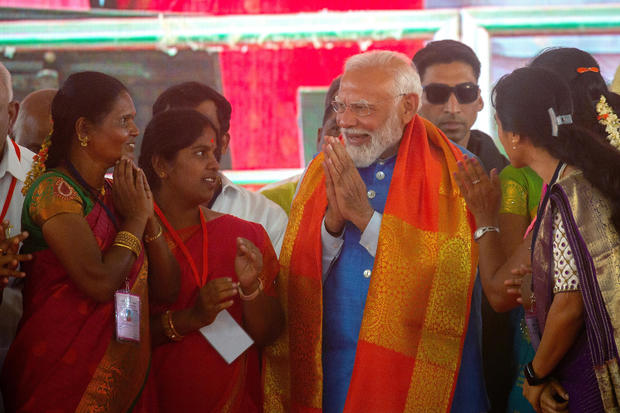
But his party's victory is not guaranteed, and there's a lot on the line — not only for the world's most populous nation , but for the wider tenets of democracy in what has been for decades a lauded example of political freedom in Asia.
Elections on an immense scale
India is home to more than 1.4 billion people. It has 969 million eligible voters this year, compared to 912 million when the last national election was held in 2019. By comparison, as the U.S. heads toward its own national election in November, fewer than 170 million people are likely to be eligible to cast ballots.
It takes India's Election Commission months of preparation and some 15 million election officers and security staff to pull off the mammoth exercise in democracy.
Electronic Voting Machines (EVMs) are, in some cases, even carried on horseback or by elephant to reach remote communities, taking as long as almost seven weeks to reach the country's far-flung corners where infrastructure can be lacking.
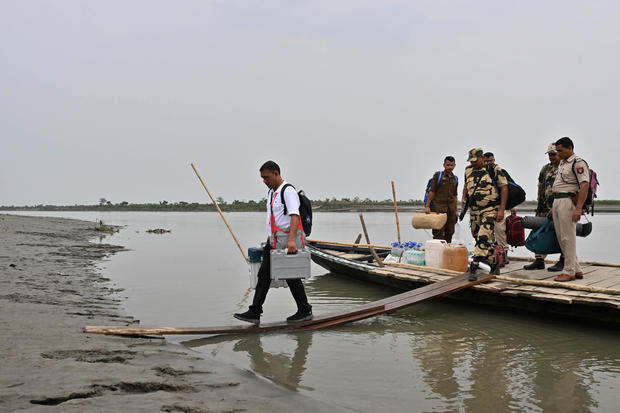
The commission has set up more than 1 million polling stations across India, with the objective being for every voter to have one within 1.24 miles of their home. One booth was being set up high in the Himalayan mountains and, at an altitude of 15,256 feet, it was billed as the world's highest polling station.
The election body said it would use 5.5 million EVMs. The machines were first introduced for India's 1982 national elections. Some opposition parties have raised concerns over the EVMs being prone to hacking and tampering, but the commission and the government have maintained that they are reliable.
Who is voting in India's elections, and for what?
Voters will be electing Members of Parliament to fill 543 seats in the 545-seat lower house of parliament, called the Lok Sabha. The other two seats are nominated by the country's president. The party that wins a majority in the election will form the next government and appoint one of its winning candidates as India's prime minister.
The contest involves six national parties, 57 state parties and more than 2,500 smaller local parties. Not all political parties field candidates nationally. Combined, fewer than 12 parties hold 86% of the seats in the Lok Sabha.
One of the main political parties is Modi's Hindu nationalist Bhartiya Janata Party (BJP), which has seen its popularity rise steadily since he won his first term in 2014.
The BJP's biggest rival is the Indian National Congress (INC), the country's oldest political party and one that has been in power for more than 50 of the 77 years of India's existence as an independent nation.
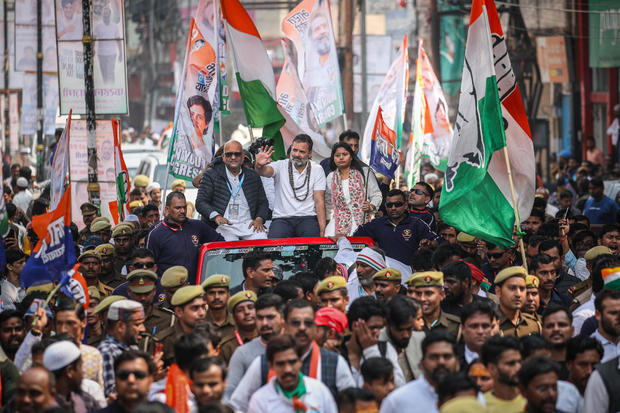
Congress leader Rahul Gandhi, whose father, grandmother and great-grandfather all served as prime ministers, is Modi's fiercest opponent and the face of the country's political opposition.
A "fair, transparent" election process?
Last month, the INC party accused Modi's government of misusing the tax federal agency to stifle democracy, announcing that it had frozen the party's bank accounts in a tax dispute case.
Former Congress leader Sonia Gandhi , the current party leader's mother, said it was "a systematic effort to cripple the party financially."
"We have no money to campaign. We cannot support our candidates. Our ability to fight elections has been damaged," Rahul Gandhi said.
The Congress Party also accused "autocratic" Modi's government of "capturing democracy through extortion and financial terrorism."
Modi's BJP government has denied the allegations.
Concerns have also been raised over the arrest of Arvind Kejriwal, the Chief Minister of the sprawling Delhi capital region and head of the Aam Aadmi Party (AAP), on March 21. He was taken into custody by the Enforcement Directorate (ED), India's federal financial crimes agency, in connection with an alleged money-laundering case.
AAP has called the case against Kejriwal, filed right before the national elections, a "political conspiracy" and accused the ED of acting like a "political wing of BJP."
Asked on March 27 about Kejriwal's arrest and the INC's accounts being frozen, State Department spokesperson Matthew Miller said the U.S. government wouldn't comment on "private diplomatic discussions," but he stressed that "we encourage fair, transparent, and timely legal processes for each of these issues."
India called the U.S. government's remarks about the issues "unwarranted" and "unacceptable," and said India was proud of its independent and robust democratic institutions.
Modi and the Hindu-Muslim divide
Modi's opponents argue that the hugely popular prime minister has done little during his decade in office to bridge the growing sectarian divide between India's majority Hindu population and its 230 million Muslims.
Critics argue that he has, instead, indirectly endorsed sectarianism in an effort to shore up support among his Hindu nationalist base.
Some fear what a third Modi term might mean for India's Muslims, believing his BJP is determined to turn the secular, pluralistic nation into a majority-ruled Hindu state.
There has been rising sectarian violence in India , with Muslims and Christians often the targets, for the past 10 years under BJP leadership.
Modi's party has consistently denied allegations that it is fueling sectarianism, and it maintains that it works for the welfare of all India's citizens, without discrimination.
- Voter Turnout
- Narendra Modi
More from CBS News

What's the mood in Iran as Israel mulls its response?

What to know about the jurors in Trump's New York trial

Full jury seated at Trump trial on third day of selection process

Georgia beach town trying to curb large annual gathering of Black students
Louisiana Gov. Jeff Landry tours Slidell tornado damage
SLIDELL, La. (WVUE) - Louisiana Gov. Jeff Landry visited Slidell on Monday (April 15), assessing the damage left behind from an EF-2 tornado that tore through the city last Wednesday.
“If you’re in the roofing business in St. Tammany Parish, I think you’re going to have plenty of business unfortunately,” Landry said. “We saw a lot of blue tarps, we saw a lot of homes that lost a number of shingles. When you get to this area, you see the destruction.”
The tornado caused significant damage, leaving many residents and businesses grappling with its aftermath.
During his visit, Landry met with local officials to discuss response efforts and assess the extent of the damage. This marks the fifth day since the tornado struck, and the community is still reeling from its impact.
Landry said the state is committed to helping not only St. Tammany Parish, but the other parishes impacted by last week’s severe weather. The state likely will cover 75% of debris removal with 25% paid for by the parish.
“We want to make sure we can clean this debris out, get all of this vegetation out of the roadways and out of people’s yards so we can get back to work,” Landry said.
Slidell Mayor Greg Cromer said, “We’re going to be trying to find apartments, vouchers for them, whatever resources we can for those folks to get a place to live until we can put this apartment complex together.”
A block from where Landry stopped, dozens of church volunteers are continuing to distribute water, cleaning supplies and other items.
Vickie Kelley, a church volunteers said she was initially excited to see the motorcade. “It was kind of interesting,” Kelley said. “I don’t know what the Governor said, but I was kind of wondering why he didn’t visit a facility like this that’s doing charity work.”
Another Slidell resident said, “Glad to see him out here and that he’s seeing what’s really going on.”
TORNADO AFTERMATH
- Slidell man takes Fox 8 inside tornado-ravaged apartment unit
- ‘I’m scared too’: Dramatic bodycam video shows flipped cars, rescue attempts following Slidell tornado
- Tornado outbreak spawned 11 across Louisiana, including 2 with winds over 111 mph
- Focus shifts to clean up following severe weather outbreak, Slidell tornado

The governor is expected to issue an executive order declaring a State of Emergency.
Landry said, “The Governor’s Office of Homeland Security and Emergency Preparedness (GOHSEP) continues to work with local officials to provide support and assist with navigating the recovery process moving forward.”
Over the weekend, the American Red Cross was on the ground in Slidell, providing much-needed support to affected residents. They distributed free hot food and water while also conducting damage assessments to facilitate the dispersal of emergency funds.
Slidell Police reported one of their motorcycle officers was injured Monday while escorting Landry’s motorcade, in a collision with an unmarked Louisiana State Police vehicle. The officer was hospitalized with what the department described as “moderate injuries.”
See a spelling or grammar error in our story? Click Here to report it. Please include the headline.
Subscribe to the Fox 8 YouTube channel .
Copyright 2024 WVUE. All rights reserved.

1 dead, 11 injured in mass shooting outside New Orleans nightclub

Zurik: Meal between Cantrell, Vappie prompts call for internal investigation

Stream news and weather 24/7

NBA YoungBoy arrested in Utah on drug, weapons charges

Pizza Madness
Latest news.

Bruce: Hot and muggy before Sunday cool front, storms

Afternoon forecast for Thurs., April 18

Nicondra: Weekend rain forecasted

NWS confirms 8 tornadoes from Slidell into Hancock County Mississippi

Morning forecast for Thurs., April 18
Taylor Swift's The Tortured Poets Department is here, but it could be a logistical nightmare for the Eras Tour
Get ready for another Taylor Swift era.
The Tortured Poets Department (TTPD) is the superstar's 11th studio album and is being released around the world today.
It'll be dropping the second the clock hits midnight on the east coast of America, which will be this afternoon in Australia.
- 2pm AEST : ACT, New South Wales, Queensland, Tasmania, Victoria
- 1:30pm ACST : Northern Territory and South Australia
- 12pm AWST : Western Australia
So far, we know the album is a whopping 16 songs (not including bonus vinyl tracks) and features multiple collaborations, including with Florence + The Machine.
We also know the first single will be Fortnight featuring Post Malone, with a music video dropping tomorrow morning as well.
Despite no singles being released in its lead up, clues point to TTPD seemingly being inspired by the five stages of grief : denial, anger, bargaining, depression and acceptance.
Plus, many fans have speculated that the album title is a reference to the name of a group chat Swift's ex was part of – The Tortured Man Club.
And while The Tortured Poets Department could very well set new streaming records, it also poses a logistical nightmare for Taylor Swift's Eras Tour: how do you include yet another album into a show that is over three hours long?
Below, two ABC reporters and Swifties weigh up the likelihood of how the megastar might adapt her sell-out tour when it recommences in Europe next month.
We could lose some songs from every era to make room
Jessica : This seems like the most likely course of action. To put things into perspective, the Eras Tour includes songs from nine albums, but their airtime varies wildly. Lover, Folklore and Midnights have at least six songs, while Speak Now gets just two. So this might be a chance to balance things out?
Georgie : It would make the most sense to me. I can't imagine a tour that doesn't spend at least some time on the freshest music. But, this is a unique scenario. You have an artist who is essentially doing a greatest hits tour at the age of 34 while she is still churning out new music.
If she does cut music to make room for Tortured Poets, it will be very divisive. Every fan has their favourite era. But, I think if she was to I would hope she cuts songs she has already toured. You have to remember she put out four (now five) albums since her last tour and I imagine it would make the most sense for her to give more air time to Lover, Folklore, Evermore, Midnights and TTPD.
Jessica : If you were in charge of Taylor Swift's setlist, which songs would you cull? I'd ditch The Archer from the Lover era so it ends with, well, Lover. I'd be ruthless and cut most of the songs from the Red era as nothing compares to All Too Well (10 Minute Version). But keep the Reputation portion as is! It's perfect.
What if smaller eras, like Fearless and Speak Now, got cut altogether?
Jessica : I love chaos so I would not bat an eye if Taylor Swift dropped the entire Speak Now era from her tour. (But Enchanted is such a core memory for a lot of fans.) I know this might be a wild concept but there's not one song from her self-titled debut album in the Eras Tour (justice for Our Song!), so make of that what you will.
Georgie : I think this will cause a major generational divide. The beautiful part about the Eras Tour is you have fans new and old coming together. Taylor has been making music since 2009 and the Eras Tour has been a chance for people in their twenties and thirties to dress up in glitter and be teenagers again while sharing the new music with teenagers today. I'm a folklore girl through and through so I am hoping if any eras get sacrificed it's the older ones. But I can't lie, it's pretty special to belt out Love Story with thousands of other people.
Could we lose the two surprise songs for a few Tortured Poets hits?
Georgie : Controversial opinion but I would be ok with this. Although, take this as you want because I have experienced the Eras Tour. But the section is a gamble anyway. You never know what she's going to play and someone is always disappointed or their top pick is played another night. If you cut this section, no-one gets hurt. Maybe she subs it out for three best songs from TTPD?
Jessica : I missed out on tickets for the Eras Tour altogether so I was taken aback seeing fans who did score tickets complaining about which night got "better" surprise songs. You can't please everyone! I agree, this would level the playing field and take the comparison factor out of the tour… but I wonder if that uniqueness is a marketing factor as some super fans attend multiple concerts in the same city.
Imagine if she just… didn't play her new album
Georgie : Don't say it or it might come true!
Jessica : I think this would be the riskiest option. Imagine the disappointment on the first night when the tour recommences in Paris on May 9. But some fans, especially in America, who witnessed the Eras Tour last year before this album was announced feel it's unfair if other countries get a different experience. But that's what happens with the passage of time!
Georgie : I see your point but you have to remember we're in an age where many people have watched the Eras Tour happen through TikTok and the cinema release. So is it really missing out when it's been inescapable for over a year? This could be a chance for the people who have waited so long for the Europe leg – who have basically watched the tour on streaming and all over TikTok – to have something unique and worth the cash.
Or she could just include the new album and make the show nearly *four hours* long?
Jessica : I think this option would please the most fans, but I genuinely don't know how she performs for hours on end each night and then travels through different time zones. Oh, to be a billionaire with a whole team taking care of everything all the time.
Georgie : I don't see this happening. Costs would skyrocket and many stadiums have a noise curfew. That's new costumes, sets and dance routines.
Jessica : But I would eat up new costumes, sets and dance routines! A four-hour concert is outrageous, which makes me think she might very well pick this option. Time will tell.
Georgie : I'm obviously a Swiftie but when I found out about the new album and what that might mean for the tour I just felt… overwhelmed. I'm still processing the release of four albums and two Taylor's Versions in four years. And now she's putting out new music? It's simply too much! The concert is a marathon but if I did have to go to a four-hour show, I'd do it for Ms Swift.
The worst option: Swapping All Too Well (10 Minute Version) for the radio edit to save time
Jessica : Sacrilegious.
Georgie : The people would riot. Jake Gyllenhaal would be thrilled though.
Final thoughts
Jessica : With everything going on in the world, I think this is a fun problem to ponder, and an interesting one for Taylor to tackle. I wish her well in whatever form the Eras Tour takes, because fans are going to have strong opinions either way.
Georgie: I worry that Taylor needs a holiday but, as you said, she's a billionaire now so I think she'll be fine. I hope she tours future albums but I also support her having a rest. Go chill with the cats and Travis. You've danced in high heeled boots for two years.
- X (formerly Twitter)
Related Stories
Taylor swift's understanding of the element of surprise is her best marketing tool.
'Do I need to give a billionaire more money?' How Taylor Swift's financial status collides with fans
Was 1989 the birth of superstar Taylor Swift or just her supersized financial ambitions? Let’s discuss
'A celebration of girlhood': Why the act of dressing up for Taylor Swift is so layered
Taylor Swift named Time magazine's Person of the Year, beating Putin, King Charles III and Barbie
- Arts, Culture and Entertainment
- Music (Arts and Entertainment)
- Music Industry
- Popular Culture
- United States

IMAGES
VIDEO
COMMENTS
Join me as I take on the Tour Divide, a 4,300km unsupported bike race that will test you in every way imaginable. The Tour Divide follows the GDMBR and Conti...
Welcome to my daily coverage of the 2023 Tour Divide. The Tour Divide is a 2700mile bikepacking race traversing the length of the USA. The Tour Divide starts...
Real life documentary on the Tour Divide / GDMBR Route: A straight dope look at the trials and tribulations of Jay Petervary's winning race effort on the 202...
The Tour Divide is an annual 2,700-mile (4,300 km) self-supported bikepacking race following the Great Divide Mountain Bike Route (GDMBR). Most of the route follows dirt and gravel roads with a few sections of pavement or singletrack sprinkled in for good measure (along with the occasional hike-a-bike section). ...
The Tour Divide is a 2700+ mile nonstop race the length of the Rockies, from Canada to Mexico. When the clock starts, you start riding, and it's a test of se...
On June 14th, 2024, Idaho-based mountain athlete, coach, and performance nutritionist Jackson Long will attempt the world's longest and arguably hardest off-...
It's been over two weeks since the Tour Divide kicked off in Banff, Alberta, and that means the leaders are starting to trickle into Antelope Wells, New Mexi...
The 4,400KM Tour Divide is an interesting bike optimisation project! 📘 The Bikepacking Bike Buyer's Guide: https://www.cyclingabout.com/bikepacking-bike-buy...
The Tour Divide challenge is simple: Race the rooftop of North America by mountain bike; travel self-supported along all 2,745 miles of Adventure Cycling Association's Great Divide Mountain Bike Route; keep moving and be moved; exist well outside one's comfort zone in tackling a cross-continent bikepacking odyssey; finish as fast as possible without cracking.
The Tour Divide, a bikepacking race from the Canadian Rockies to the U.S. border with Mexico, has always been a test of fortitude. But extreme weather is making it much more dangerous. Geof Blance ...
The Great Divide Route is the world's longest off-pavement cycling route. It was tirelessly mapped over a 4 year span, and published in 1998 by Adventure Cycling Association, North America's premiere bicycle travel organization. The route is highlighted by long dirt roads and jeep trails that wend their way through forgotten passes of the ...
This is my 2016 Tour Divide ride. I actually shot this footage to be used in small clips to send back along the route to keep my friends and loved ones up t...
The race. Covering a distance of 4,300km, the Tour Divide is one of the longest and arguably the hardest ultra-endurance bike race on the planet. From Banff (Alberta) in Canada, to Antelope Wells (NM) at the border of Mexico, the course takes the riders along breathtaking scenic landscapes of the Great Divide Mountain Bike Route (designed by ...
The Tour Divide is arguably the most popular bikepacking event ever, and each year, hundreds of riders from across the globe gather in Banff, Alberta, with plans to ride the roughly 2,700-mile route along the Great Divide Mountain Bike Route south toward Mexico. There's a vast range of riders in the 2023 edition, from ultralight endurance ...
The 2023 Tour Divide begins on Friday, June 9th, at 8 a.m. with around 200 riders following the roughly 2,700-mile Great Divide Mountain Bike Route from north to south starting in Banff, Alberta, Canada, and finishing at the US/Mexico border in Antelope Wells, New Mexico. The current record was set back in 2016 by the late Mike Hall (13 days ...
STEP 1: RACE OR TOUR. RACING PROS: Racing in the company of others (There's no guarantee others will be racing near you). Chance to test yourself in one of the worlds longest MTB races. Bond with fellow racers in a shared experience. TOURING PROS: No limitation of start time, route, or direction.
As someone attracted to pedaling at an unhurried pace that allows time to soak in the surroundings and experience the local culture, Ty Domin was initially skeptical about racing the Tour Divide. Still, something compelled him to give a whirl. In this piece, explores the eye-opening experiences that helped him fully appreciate the iconic race ...
Photos by Ryan Hill. In a highly anticipated effort over the summer, 31-year-old Australian pro cyclist Lachlan Morton pedaled the iconic 2,670-mile Tour Divide route across five states and a couple of Canadian provinces in a mind-boggling 12 days, 12 hours, and 21 minutes, making him the fastest person ever to complete the route between Banff, Alberta, Canada, and Antelope Wells, New Mexico.
The Tour Divide isn't won in a day or two or three. The current record is 13 days, 22 hours, 51 minutes. Every minute counts the same as any other. To establish a fast time, you need to have the mental fortitude to sustain a level of urgency over a two-week period. As Mike Hall said, "You must crave miles.".
Live tracking event map for Tour Divide 2023 - The iconic 2700 mile race across the Great Divide Mountain Bike Route. Includes leaderboard coverage, race flow, replay and links to individual track history pages. Home Features Portfolio Trail Tracking About / Contact Tour Divide 2023 Live Tracker ...
TOUR DIVIDE. The Tour Divide is not an sanctioned or organized race in any way. Consequently it's regarded as large group ride that follows a fixed route, a set time, a set of simple rules and that's all. Those who partake should understand this and obey the gentleman's agreement to "race" fairly and follow the rules.
Riding the Great Divide Mountain Bike Route (GDMBR) or racing the Tour Divide is a rite of passage for many bikepackers; it's seen as the "Big One" in North America. Stretching 2,745 miles from Banff, Alberta to Antelope Wells, New Mexico, it loosely follows the Continental Divide through the Rocky Mountains on a series of dirt and paved ...
Banff, Canada. Running from Banff, Canada to Antelope Wells on the US-Mexican border, the Tour Divide is for many the halo event of Bikepack Ultraracing. There are both Southbound and Northbound riders racing self-supported along the ACA's Great Divide Mountain Bike Route, always with a few weather re-routes to spice it up. 17:00, 13 June, 2024.
India's Congress Party leader Rahul Gandhi (sitting atop a vehicle and waving) takes part in a procession during a campaign tour, Feb. 17, 2024, in Varanasi, India. ABHISHEK MISHRA/Getty
SLIDELL, La. (WVUE) - Louisiana Governor Jeff Landry is scheduled to tour Slidell on Monday (April 15), assessing the aftermath of an EF-2 tornado that tore through the city. The tornado caused ...
Georgie: It would make the most sense to me.I can't imagine a tour that doesn't spend at least some time on the freshest music. But, this is a unique scenario. You have an artist who is ...